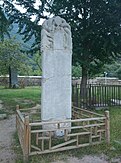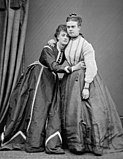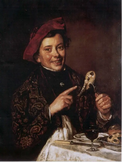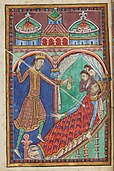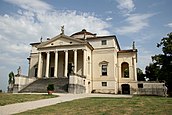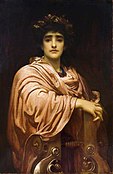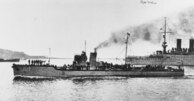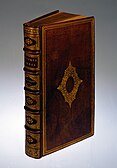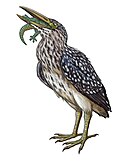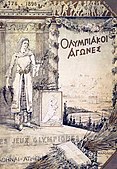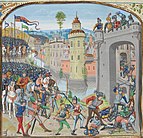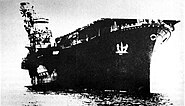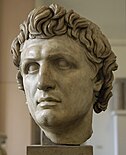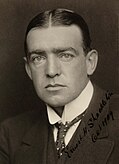User:Gog the Mild/Blurbs/Archive 2
| This is an archive of past discussions about User:Gog the Mild. Do not edit the contents of this page. If you wish to start a new discussion or revive an old one, please do so on the current main page. |
| Archive 1 | Archive 2 |
Posted
Suicidal Tour
The Suicidal Tour took place when Brazilian professional football club Santa Cruz Futebol Clube toured the North Region of Brazil from 2 January 1943 to 29 April 1943. Over almost four months, they played either 26 or 28 friendly matches in six cities. The tour gained its name due to the misfortunes endured by the club. Looking to recover from a financial crisis, Santa Cruz arranged five matches in Belém, Pará. Traveling up the Amazon River for another round of matches, they first started experiencing problems in Manaus, where two players left to play for other clubs and seven members of the team's delegation caught dysentery. Two players went on to catch typhoid fever and died. Unable to return home through the sea, and needing to cover growing costs, Santa Cruz had to return to Recife by land, playing matches along the way to earn money. The return had further problems, including a fake arrest warrant for a player, a trip alongside thieves, and two train derailments. (Full article...)
characters, including spaces.
Myalgic encephalomyelitis/chronic fatigue syndrome
Myalgic encephalomyelitis/chronic fatigue syndrome (ME/CFS) is a disabling chronic illness. People with ME/CFS experience profound fatigue that does not go away with rest, sleep issues, and problems with memory or concentration. The hallmark symptom is a worsening of the illness which starts hours to days after minor physical or mental activity, and lasts from hours to several months. The cause of the disease is unknown. ME/CFS often starts after an infection, and many people fit ME/CFS diagnostic criteria after contracting long COVID. Diagnosis is based on symptoms because no diagnostic test is available. The illness can improve or worsen over time, but full recovery is uncommon. No therapies or medications are approved to treat the condition, and management is aimed at relieving symptoms. About a quarter of those affected are unable to leave their bed or home. People with ME/CFS often face stigma in healthcare settings, and care is complicated by controversies around the cause and treatments of the illness. (Full article...)
1,042 characters, including spaces.
Siege of Constantinople (674–678)

The first Arab siege of Constantinople in 674–678 was a major conflict of the Arab–Byzantine wars, and the first culmination of the Umayyad Caliphate's expansionist strategy towards the Byzantine Empire. In 672–673 Arab fleets secured bases along the coasts of Asia Minor, and set up a loose blockade around Constantinople. They used the peninsula of Cyzicus near the city as a base to spend the winter, and returned every spring to launch attacks against the city's fortifications. Finally the Byzantines managed to destroy the Arab navy using a new invention, the liquid incendiary substance known as Greek fire. The Byzantines also defeated the Arab land army in Asia Minor, forcing them to lift the siege. A peace treaty was signed, and following the outbreak of another Muslim civil war, the Byzantines experienced a brief period of ascendancy. The siege was the first major Arab defeat in 50 years of expansion. Tales of a large-scale siege of Constantinople even reached China. (Full article...)
1,002 characters, including spaces.
The Importance of Being Earnest
The Importance of Being Earnest is a drawing-room comedy by Oscar Wilde, premiered on 14 February 1895 in London. It depicts the affairs of two young men about town who lead double lives to evade unwanted social obligations, both assuming the name Ernest to woo two young women. Other characters are the formidable Lady Bracknell, the fussy governess Miss Prism and the benign and scholarly Canon Chasuble. The play, celebrated for its wit and repartee, parodies contemporary dramatic norms and comically satirises late Victorian manners. The triumphant opening night was followed within weeks by Wilde's downfall and imprisonment for homosexual acts and the closure of the production, and Wilde wrote no more comic or dramatic works. From the early 20th century onwards the play has been revived frequently and adapted for radio, television, film, operas and musicals. (Full article...)
characters, including spaces.
Edith Roosevelt
Edith Roosevelt (August 6, 1861 – September 30, 1948; née Carow) was the second wife of President Theodore Roosevelt and the First Lady of the United States from 1901 to 1909. Edith grew up alongside the Roosevelt family, and married Theodore Roosevelt in 1886, having five children. Edith became a public figure when her husband became a war hero in the Spanish–American War and was elected governor of New York. Theodore became Vice President in March 1901, and President after the assassination of President William McKinley September. Edith controlled when and how the press reported on the Roosevelts, and regulated Washington social life, organizing weekly meetings of the cabinet members' wives, and becoming the gatekeeper of who could attend formal events. Her oversight of the 1902 White House renovations and her hiring the first social secretary for a first lady, Belle Hagner, are considere enduring legacies. She remained politically active, despite poor health from the 1910s. (Full article...)
1,009 characters, including spaces.
Atrociraptor
Atrociraptor is a genus of dromaeosaurid dinosaur that lived during the Late Cretaceous in what is now Alberta, Canada. The first specimen was discovered in 1995 by the fossil collector Wayne Marshall in the Horseshoe Canyon Formation. In 2004, this became the holotype of the new genus and species Atrociraptor marshalli; the generic name is Latin for "savage robber". It is estimated to have measured 1.8–2 m (5.9–6.6 ft) in length and weighed 15 kg (33 lb). It would have had a large sickle-claw on the second toe and pennaceous feathers. Atrociraptor has a deeper face and more strongly backwards inclined teeth than its contemporary relatives. It is thought to have been specialised for attacking larger prey due to its deep snout. Studies suggest dromaeosaurids used their sickle-claws to restrain prey while dismembering them with the mouth. Atrociraptor dates from around 72.2 – 71.5 million years ago; it survived for over 2 million years and across a wide geographic area. (Full article...)
1,000 characters, including spaces.
Wolverton Viaduct
Wolverton Viaduct is a railway bridge carrying the West Coast Main Line over the River Great Ouse to the north of Wolverton, part of Milton Keynes, in south-eastern England. Built in 1838 for the London and Birmingham Railway (L&BR) to the design of Robert Stephenson, it was the largest viaduct on the L&BR's route. It is in the centre of Wolverton Embankment, itself the largest on the line. It has six brick arches and covers a distance of 660 feet (200 metres), reaching a maximum height of 57 feet (17 metres) above the river, and terminating in substantial abutments which contain decorative arches. Several contemporary commentators likened Stephenson's bridges to Roman aqueducts. The viaduct was widened to take four tracks in the 1880s with a blue-brick extension, in contrast to the red-brick original. Masts for overhead electrification were added in the 1950s but otherwise the bridge is little changed since it was built and it is now a Grade II listed building. (Full article...)
994 characters, including spaces.
The Girl Who Lived in the Tree
The Girl Who Lived in the Tree is the thirty-second collection by British fashion designer Alexander McQueen, made for the Autumn/Winter 2008 season. The primary inspirations were British culture and national symbols, particularly the British monarchy, as well as the clothing of India during the British Raj. It was presented through the narrative of a fairy tale about a feral girl who lived in a tree before falling in love with a prince and descending to become a princess. The collection's runway show was staged on 29 February 2008 at the Palais Omnisports de Paris-Bercy in Paris. Forty-two looks were featured in two phases: during the first the ensembles were all in black and white, with most having a slim, tailored silhouette; those from the second were richly coloured, with luxurious materials and embellishments. Critical response was positive, and in retrospect it is regarded as one of McQueen's best collections. Garments from the collection are held by various museums. (Full article...)
1,006 characters, including spaces.
Laysan honeycreeper
The Laysan honeycreeper (Himatione fraithii) is an extinct species of finch, first recorded in 1828, that was endemic to Laysan in the Northwestern Hawaiian Islands. Its length was 13–15 cm (5–6 in) with a 64–69 mm (2.5–2.7 in) long wing. It was bright scarlet vermilion with a faint tint of golden orange on the head, breast and upper abdomen; the rest of its upper parts were orange scarlet. The lower abdomen was dusky gray fading into brownish white. The wings, tail, bill, and legs were dark brown. The bill was slender and downturned. It was nectarivorous and insectivorous, gathering nectar and insects from flowers. The breeding season was probably between January and June, and the clutch size was four or five eggs. In 1903, domestic rabbits were introduced to the island and destroyed its vegetation. In April 1923, only three Laysan honeycreepers were found, one of which was filmed. On April 23, a sandstorm hit the island, and the last birds perished due to lack of cover. (Full article...)
1,004 characters, including spaces.
Ole Miss riot of 1962
The Ole Miss riot of 1962 was a violent disturbance at the University of Mississippi—commonly called Ole Miss—in Oxford, Mississippi, as Segregationist rioters sought to prevent the enrollment of an African American applicant, James Meredith. In the wake of the Supreme Court's 1954 decision Brown v. Board of Education, Meredith applied to Ole Miss in 1961. His admission was delayed and obstructed, including by Mississippi Governor Ross Barnett. Barnett even had Meredith temporarily jailed. Multiple attempts by Meredith, accompanied by federal officials, to enroll were physically blocked. A riot erupted on campus when a mob assaulted reporters and federal officers, burned and looted property, and hijacked vehicles. Two civilians were murdered and 160 marshals were injured, including 28 who received gunshot wounds. Kennedy invoked the Insurrection Act of 1807, mobilized more than 30,000 troops, and quelled the riot. A statue of James Meredith on campus commemorates the event. (Full article...)
1,006 characters, including spaces.
Hudson Volcano
Hudson Volcano is a volcano in the rugged mountains of southern Chile. Lying in the Southern Volcanic Zone of the Andes, it was formed by the subduction of the oceanic Nazca Plate under the continental South American Plate. Hudson has the form of a 10-kilometre-wide (6-mile) volcanic caldera filled with ice. The volcano has erupted numerous times in the past 2.5 million years forming widespread tephra deposits, and is the most active volcano in the region. Four large eruptions have taken place in the past 20,000 years: 17,300–17,440 before present (BP), 7,750 BP, 4,200 BP, and in 1991. The 7,750 BP eruption was among the most intense volcanic eruptions in South America during the Holocene, devastated the local ecosystem and may have caused substantial shifts in human settlement and lifestyle. During the 1991 eruption, volcanic ash covered a large area in Chile and Argentina, and was deposited as far as Antarctica. The last eruption was in 2011. (Full article...)
976 characters, including spaces.
Cross Temple, Fangshan
The Cross Temple is a former place of worship in Fangshan, Beijing. Built as a Buddhist temple, it may have seen Christian use during the Tang dynasty (618–907). The temple was used by Buddhists during the Liao dynasty (916–1125), by Christians during the Yuan dynasty (1271–1368), returned to Buddhist use during the Ming dynasty (1368–1644), and was sold by them in 1911. Its first modern mention was in 1919. Cross Temple was damaged during the Cultural Revolution but recognised as a national-level protected site in 2006. Some scholars consider it to be the only place of worship of the Church of the East (also known as Nestorian Christianity) discovered in China. In the early 20th century, two stone blocks carved with crosses were discovered, one of them had an inscription in Syriac; they are presently on display at Nanjing Museum. Today, the site features two ancient steles dating to the Liao and Yuan dynasties, some groundwork and the bases of several pillars. (Full article...)
993 characters, including spaces.
Battle Birds
Battle Birds was an American air-war pulp magazine, published by Popular Publications. It was launched at the end of 1932, but did not sell well, and in 1934 the publisher turned it into an air-war hero pulp titled Dusty Ayres and His Battle Birds. Robert Sidney Bowen, an established pulp writer, provided the lead novel each month, and also wrote the short stories that filled out the issue. Bowen's stories were set in the future, with the United States menaced by an Asian empire called the Black Invaders. The change was not successful enough to be extended beyond the initial plan of a year, and Bowen wrote a novel in which, unusually for pulp fiction, Dusty Ayres finally defeated the invaders, to end the series. The magazine ceased publication with the July/August 1935 issue. It restarted in 1940, under the original title, Battle Birds, and lasted for another four years. All the cover art was painted by Frederick Blakeslee. (Full article...)
955 characters, including spaces.
Blackrocks Brewery
Blackrocks Brewery is a craft brewery and taproom in Marquette, Michigan. Taking the name from a local landmark, former pharmaceutical salesmen David Manson and Andy Langlois opened Blackrocks in 2010. At the time, it was a nanobrewery with a small brewing system in the basement of a Victorian-style house. Two other floors formed the brewery's taproom. High demand for Blackrocks' beer quickly led them to add to their brewing capacity with larger systems and by purchasing a former Coca-Cola bottling plant. The brewery's taproom was expanded into an adjacent property in the early 2020s, doubling its available indoor area. An outdoor patio with firepits is also available. Blackrocks produced about 12,687 barrels of beer in 2023, up about 11% from the year prior, and As of 2024[update] is the largest brewery in Michigan's Upper Peninsula. Their most popular beer is 51K, an American IPA named for a local ski marathon. (Full article...)
936 characters, including spaces.
Cerro Panizos

Cerro Panizos is a late Miocene-age shield-shaped volcano, made up of two depressions formed by the collapse of volcanos (calderas) and a group of lava domes. It consists of ignimbrites and is in the Potosí Department of Bolivia and the Jujuy Province of Argentina. It is one of several ignimbrite or caldera systems that, along with 44 active stratovolcanoes, are part of the Andean Central Volcanic Zone (CVZ). Subduction of the Nazca Plate beneath South America is responsible for most of the volcanism in the CVZ. Panizos is the source of two major ignimbrites: Cienago ignimbrite erupted about 7.9 million years ago; and the more recent Panizos ignimbrite, erupted 6.7 million years ago. The Panizos ignimbrite has a total volume exceeding 650 cubic kilometres (160 cu mi). Several volcanic cones such as Limitayoc were active between the ignimbrite eruptions, and a plateau of lava flows and lava domes formed in the central area of the Panizos ignimbrite after the last eruptions. (Full article...)
1,005 characters, including spaces.
Snooker

Snooker is a cue sport played on a rectangular billiards table covered with a green cloth called baize, with six pockets. First played by British Army officers stationed in India in c. 1875, the game uses twenty-two balls, comprising a white cue ball, fifteen red balls, and six other balls—collectively called the colours. Using a cue stick, the individual players or teams take turns to strike the cue ball to pot other balls in a predefined sequence, accumulating points for each successful pot and for each time the opposing player or team commits a foul. An individual frame of snooker is won by the player who has scored the most points. A snooker match ends when a player wins a predetermined number of frames. The standard rules of the game were first established in 1919. As a professional sport, snooker is now governed by the World Professional Billiards and Snooker Association. Top players of many nationalities compete in regular tournaments around the world, earning millions of pounds. (Full article...)
1,019 characters, including spaces.
Kes (Star Trek)
Kes is a fictional character on the science fiction television show Star Trek: Voyager, played by Jennifer Lien. Kes joins the crew of the starship USS Voyager in the pilot episode, opening an aeroponics garden and working as a medical assistant. She is a member of a telepathic alien species with a life span of only nine years. She leaves the ship in the fourth season after her powers threaten to destroy it. She reappears in a season six episode and features in Star Trek: Voyager novels and short stories. Voyager's creators intended Kes to provide audiences with a different perspective on time. Although Kes is portrayed as fragile and innocent, she is also shown as having hidden strength and maturity. Voyager's producers reluctantly fired Lien after her personal issues affected her reliability on set. Kes was a fan favorite character while Voyager was airing, although critics reacted more negatively, finding her boring and without a clear purpose. Lien was praised for her performance. (Full article...)
1,017 characters, including spaces.
Bäckadräkten
Bäckadräkten is Sweden's first unisex folk costume, designed in 2022 by musician Fredy Clue and textile designer Ida Björs. Their mission was to encourage wider participation in folk traditions by providing an outfit that is not restricted to any gender or geographic region. The design merges elements traditionally considered either male or female and borrows heavily from older folk costumes. The release generated international press attention and discussions on social media, much of the latter about the relationship between folk arts and gender. Many welcomed the design, saying it provides an opportunity for non-binary Swedes to be more involved in folk culture. Others reacted negatively, resisting the social change they see as associated with it. Clue released a sewing pattern in 2023 and started taking custom orders by 2024, encouraging users to modify as they see fit. Said Clue: "The real work continues with us learning to listen to oneself and others." (Full article...)
characters, including spaces.
Tiger
The tiger (Panthera tigris) is the largest living cat species and a member of the genus Panthera native to Asia. It has a powerful, muscular body with a large head and paws, a long tail, and orange fur with black stripes. It inhabits mainly forests, and is an apex predator preying mainly on ungulates such as deer and wild boar, which it takes by ambush. It lives a mostly solitary life and occupies home ranges, which it defends from individuals of the same sex. The range of a male tiger overlaps with that of multiple females with whom he mates. Females give birth to usually two or three cubs that stay with their mother for about two years before establishing their own ranges. Since the early 20th century, the tiger has lost at least 93% of its historic range and is listed as endangered on the IUCN Red List of Threatened Species. The tiger featured prominently in the ancient mythology and folklore of cultures throughout its historic range and continues to appear in culture worldwide. (Full article...)
1,014 characters, including spaces.
U.S. Route 101

U.S. Route 101 is a north–south highway traversing the states of California, Oregon, and Washington on the West Coast of the United States and running for over 1,500 miles (2,400 km) along the Pacific Ocean. It was established in 1926 and followed several historic routes linking California's early Spanish missions, pueblos, and presidios. Several sections were rebuilt in the mid-20th century to eliminate curves and address traffic congestion. Later projects expanded or relocated sections of the highway. The highway's southern terminus is at a major interchange with Interstate 5 (I-5) and I-10 in Los Angeles. It notably traverses San Francisco on city streets to reach the Golden Gate Bridge. In Washington US 101 travels north, east and then south around the Olympic Peninsula to its northern terminus in Tumwater, near Olympia. Several portions of the highway are designated as scenic byways, and it serves three national parks: Pinnacles, Redwood, and Olympic. (Full article...)
characters, including spaces.
St Melangell's Church
St Melangell's Church is a medieval building of the Church in Wales located in the Tanat Valley, Powys, Wales. It was founded c. the 8th century to commemorate the reputed grave of Melangell, a local hermit and abbess. The church is built of several types of stone, and has a single nave and a square tower. It is a Grade I listed building. On the east end is an apse, which by tradition contains Melangell's grave. The current church was built in the 12th century, with major restoration work in the 19th and 20th centuries. The interior of the church holds a 15th-century rood screen depicting Melangell's legend, two 14th-century effigies, paintings, and liturgical fittings. It also contains the reconstructed 12th-century shrine to Melangell, considered the oldest surviving Romanesque shrine in northern Europe. it was a major centre of cult activity in Wales until the Reformation and continues to attract pilgrims into the 21st century. (Full article...)
962 characters, including spaces.
Homeric Hymns

The Homeric Hymns are a collection of thirty-three ancient Greek hymns and one epigram praising individual deities of the Greek pantheon and retelling mythological stories. In antiquity, the hymns were generally attributed to the poet Homer: modern scholarship has established that most are of a later date. They may originally have been performed by singers accompanying themselves on a lyre. The hymns influenced Alexandrian and Roman poets, and both pagan and early Christian literature. The Homeric Hymns were first published in print by in 1488–1489, while George Chapman made the first English translation in 1642. They have inspired or influenced Handel, Goethe, Shelley and Tennyson. Their influence has also been traced in the novels of James Joyce and Neil Gaiman, and the films of Alfred Hitchcock. Their textual criticism progressed considerably over the nineteenth century, though the text continued to present substantial difficulties into the twentieth. (Full article...)
988 characters, including spaces.
Battle of Winwick
The Battle of Winwick was fought on 19 August 1648 between a Scottish Royalist army and a Parliamentarian army during the Second English Civil War. The Scottish army invaded north-west England and was attacked and defeated at Preston on 17 August. The surviving Royalists fled south, closely pursued. Two days later, hungry, cold, soaking wet, exhausted and short of dry powder, they turned to fight at Winwick. Parliamentarian infantry launched a full-scale assault which resulted in more than three hours of furious but indecisive close-quarters fighting. The Parliamentarians fell back, pinned the Scots in place with their cavalry and sent their infantry on a circuitous flank march. When the Scots saw this force appear on their right flank they broke and fled. Parliamentarian cavalry pursued, killing many. The surviving Scottish infantry surrendered either at Winwick church or in nearby Warrington; their cavalry on 24 August at Uttoxeter. Winwick was the last battle of the war. (Full article...)
1,006 characters, including spaces.
Alice of Champagne
Alice of Champagne {c. 1193 – 1246) was the was the eldest daughter of Queen Isabella I of Jerusalem and Count Henry II of Champagne. In 1210, Alice married her stepbrother King Hugh I of Cyprus, receiving the County of Jaffa as dowry. After her husband's death in 1218, she assumed the regency for their infant son, King Henry I. Alice attempted to bolster her claim to Champagne and Brie, but the kings of France refused to acknowledge her title. In 1223 she married Bohemond, heir apparent to the Principality of Antioch and the County of Tripoli, but their marriage was annulled because they were too closely related. In 1229, she unsuccessfully laid claim to the Kingdom of Jerusalem against the infant Conrad IV. In 1240, she married Raoul of Nesle and the High Court of Jerusalem proclaimed them regents for Conrad in 1243, although their power was only nominal. Raoul left the kingdom, and Alice, before the end of the year. Alice retained the regency until her death in 1246. (Full article...)
1,002 characters, including spaces.
Rhodesia Information Centre
The Rhodesia Information Centre (RIC) represented the Rhodesian government in Australia from 1966 to 1980. As Australia did not recognise Rhodesia's independence it operated on an unofficial basis. The centre's activities included lobbying politicians, spreading propaganda about white minority rule in Rhodesia and advising Australian businesses on how they could evade the United Nations sanctions that had been imposed on the country. These activities violated United Nations Security Council resolutions. The RIC had little impact, with Australian media coverage of the Rhodesian regime being almost entirely negative and the government's opposition to white minority rule in Rhodesia hardening over time. The Australian government made several attempts to force the centre to close, all of which were unsuccessful. The Zimbabwean government shut the centre in May 1980 after the end of white minority rule and later established an official embassy in Australia. (Full article...)
984 characters, including spaces.
Robert Howard Hodgkin
Robert Howard "Robin" Hodgkin taught at Queen's College, Oxford. He was appointed a lecturer of modern history in 1900, made a fellow in 1904, a tutor in 1910, and held the post of university lecturer in modern history from 1928 to 1934. In 1900 he volunteered to serve in the Northumberland Fusiliers during the Second Boer War and re-joined during the First World War. In 1936 and 1937, he was pro-provost when B. H. Streeter fell ill, resumed teaching in April, and retired towards the end of the year. A week later Streeter (now returned to his duties) died in a plane crash, and Hodgkin was asked to take on the role of provost permanently, which he did until 1946. Hodgkin was remembered for his dedication, his flexible teaching style, for shepherding the college through the wartime years, for the reconstruction of the college's grand library, and for his book on the college's history. He was particularly known for his 1935 work, A History of the Anglo-Saxons. (Full article...)
989 characters, including spaces.
NERVA
The Nuclear Engine for Rocket Vehicle Application, or NERVA, was a rocket engine development program intended to establish a technology base for nuclear thermal rocket systems for space missions, as this promised to be more efficient than chemical rockets. NERVA was a joint effort of the Atomic Energy Commission (AEC) and NASA, and was managed by the Space Nuclear Propulsion Office (SNPO). NERVA was considered a successful program in that it met or exceeded its program goals and demonstrated that nuclear thermal rocket engines were a feasible and reliable tool for space exploration. At the end of 1968 SNPO deemed that the NERVA engine met the requirements for a human mission to Mars. It had strong political support but was cancelled by President Richard Nixon in 1973. Although NERVA engines were built and tested largely with flight-certified components and the engine was deemed ready for integration into a spacecraft, they never flew in space. (Full article...)
975 characters, including spaces.
Hungarian nobility

The Hungarian nobility were initially a diverse body of people, but from the late 12th century only high-ranking royal officials were regarded as noble. Most claimed ancestry from chieftains of the period preceding the establishment of the kingdom around 1000; or were descended from western European knights who settled in Hungary. Only those who owned lands free of obligations were regarded as true noblemen, but other groups, known as conditional nobles, also existed. According to customary law, only males inherited noble estates. The poorest nobles lost their tax exemption from the mid-16th century. The ennoblement of whole groups was not unusual in the 17th century, 10,000 hajdú received nobility as a group in 1605. After the Diet was divided into two chambers in 1608, noblemen with a hereditary title had a seat in the upper house. Reformist noblemen demanded the abolition of noble privileges from the 1790s but noble titles were only abolished in 1947, after Hungary was proclaimed a republic. (Full article...)
1,027 characters, including spaces.
Henry II
Henry II was king of England from 1154 until his death in 1189. At various points in his life, he controlled England; large parts of Wales and Ireland; and a large part of France. He was an energetic and ruthless ruler. During the early years of his reign he restored the royal administration in England and re-established hegemony over Wales. Henry's desire to control the English Church led to conflict with Thomas Becket, the Archbishop of Canterbury, resulting in Becket's murder in 1170. Henry expanded his lands at the expense ofFrance. As his sons grew up there were tensions over the future inheritance of the kingdom. Henry was succeeded by his son Richard I; two more of Henry's sons would also rule as king. Henry's territorial expansion quickly collapsed, but many of his changes endured: Henry is generally considered to have laid the basis for the English Common Law, while his intervention in Brittany, Wales and Scotland shaped the development of their societies and governmental systems. (Full article...)
1,023 characters, including spaces.
Edward Dando
Edward Dando was a thief who over-ate at food stalls and inns, then revealed that he had no money to pay. He was particularly fond of oysters, once eating 300 at a sitting. Dando began his thefts in about 1826 and was arrested at least as early as 1828. Most of his activity was in London or Kent. He would often leave a house of correction and go on an eating spree the same day, be arrested straight away, and put back in prison. At least once he was placed in solitary confinement after he stole the rations of his fellow prisoners. While in prison in August 1832, Dando caught cholera and died. His death, like his exploits, was widely and sympathetically reported in the press. His name entered the public argot as a term for someone who eats excessively and does not pay, and he was the subject of numerous poems and ballads. William Makepeace Thackeray wrote a short story loosely based on Dando, which was made into a play. Charles Dickens wrote about Dando, comparing him to Alexander the Great. (Full article...)
1,022 characters, including spaces.
Irish nationality law
The primary law governing nationality of the Republic of Ireland is the Irish Nationality and Citizenship Act, 1956, which came into force on 17 July 1956. All persons born in the Republic before 1 January 2005 are automatically citizens by birth regardless of the nationalities of their parents. Individuals born in the country since that date receive Irish citizenship at birth if at least one of their parents is an Irish citizen or entitled to be one, a British citizen, a resident with no time limit of stay in either the Republic or Northern Ireland, or a resident who has been domiciled on the island of Ireland for at least three of the preceding four years. Persons born in Northern Ireland are usually entitled to – but not automatically granted – Irish citizenship, largely under the same terms. Foreign nationals may become Irish citizens by naturalisation after meeting a minimum residence requirement, usually five years. The President of Ireland may also grant honorary citizenship, which entails the same rights and duties as normal citizenship, although this is rare.
1,084 characters, including spaces.
Epsom riot

The Epsom riot took place on 17 June 1919 when between 300 and 800 Canadian soldiers rioted and attacked the police station in Epsom, Surrey, England. With the First World War over, discipline at Canadian camps was relaxed. Delays in repatriation caused discontent among Canadian troops. The Epsom riot began when two Canadian servicemen were arrested following a disturbance at a local public house. Their comrades marched on the town police station to demand their release. In the ensuing fighting, Private Allan McMaster, a former blacksmith, picked up a metal bar and struck Station Sergeant Thomas Green, a British police officer, on the head. Green died the following day. Seven men appeared in court: they were found guilty of rioting, but were acquitted of manslaughter, and served several months in prison. Ten years after returning to Canada, McMaster, one of those imprisoned, confessed to the killing. As he had already been found innocent of manslaughter, he was not returned to the UK. (Full article...)
1,017 characters, including spaces.
Supermarine S.4
The Supermarine S.4 was a 1920s British single-engined monoplane built to race in the 1925 Schneider Trophy contest. To reduce drag forces and so increase speed the company's chief designer, R. J. Mitchell, produced a floatplane of revolutionary design. Built of wood, and with an unbraced cantilever wing, it was powered by a Napier Lion engine developed to produce 700 horsepower (520 kW) over a short racing period. Less than a month after its maiden flight on 24 August 1925, it raised the world's seaplane speed record to 226.752 miles per hour (364.922 km/h). During navigation trials on 23 October, the aircraft was performing well when—for reasons that have not been fully explained—it went out of control and was destroyed when it dived into the sea from 100 feet (30 m), injuring the pilot. Mitchell used the practical experience gained from his work on the S.4 when designing its immediate successor, the Supermarine S.5. (Full article...)
950 characters, including spaces.
1995 Aigio earthquake
The 1995 Aigio earthquake struck Western Greece near the coastal city of Aigio at 03:15:48 local time on 15 June, 1995. The second destructive earthquake to strike Greece in a month, it measured 6.4–6.5 on the moment magnitude scale (Mw )and generated the strongest ground motion ever recorded in Greece. Fifteen minutes after the mainshock, a large aftershock struck. Faulting occurred on either the Aigion fault or an unnamed offshore fault. Significant destruction occurred; the collapse of two buildings left 26 dead and up to 200 injured. Monetary damages from the earthquake reached $660 million (in 1995 USD). The Greek government issued seismic loans to aid in the rebuilding of Aigio, though it may have encouraged the construction of taller buildings—increasing Aigio's future seismic hazard. Controversy arose over the lack of a warning for the earthquake, as several sources warned officials that a major earthquake would occur. (Full article...)
958 characters, including spaces.
Archaeology, Anthropology, and Interstellar Communication
Archaeology, Anthropology, and Interstellar Communication is a collection of essays edited by Douglas Vakoch and published by NASA. The book is focused on the role that the humanities and social sciences play in the search for extraterrestrial intelligence (SETI). An e-book version has been available on NASA's website from May 2014. Its four sections explore the history of SETI; archaeological comparisons for human-alien communication, such as the difficulties of translating ancient languages; the inferential gap between humans and aliens, and the consequences for communication and trade; and the potential nature of alien intelligences. On release the book received widespread media coverage and generally positive reviews. It was at the center of controversy regarding misinterpretation of one of its essays: A quote about ancient terrestrial stone carvings, rhetorically stating that they "might have been made by aliens" for all that they were understood by modern anthropologists, was misreported by publications such as TheBlaze, The Huffington Post, and Artnet. (Full article...)
1,093 characters, including spaces.
Cherry Valentine

Cherry Valentine was the stage name of George Ward (30 November 1993 – 18 September 2022), an English drag queen and mental health nurse who competed in the second series of the television show RuPaul's Drag Race UK. Raised in an English Traveller community, Ward was the first member of his family to attend university, where he was introduced to Manchester's drag scene. He began performing as Cherry Valentine in 2016, while working in a children's psychiatric intensive-care unit. As part of the LGBT community, Ward hid his Traveller heritage because he feared he might receive "hate or backlash". Ward has been credited as the first contestant on the Drag Race franchise to acknowledge his Romani heritage. In 2022, he addressed his background in the BBC documentary film Cherry Valentine: Gypsy Queen and Proud, and in an episode of the documentary series God Shave the Queens. Following Ward's death in 2022, a memorial concert and fundraiser was held at London's Clapham Grand. (Full article...)
1,004 characters, including spaces.
Mick Jagger
Mick Jagger is an English singer and songwriter. He was born and grew up in Dartford, joining the rock band the Rolling Stones in 1962 as the lead vocalist and one of the founder members. His songwriting partnership with Keith Richards is one of the most successful in history. Jagger has been widely described as one of the most popular and influential frontmen in the history of rock music. He gained notoriety for his romantic involvements and illicit drug use, and was often portrayed as a countercultural figure. He has also released four solo albums and starred in two films. In 1989, Jagger was inducted into the Rock and Roll Hall of Fame, and into the UK Music Hall of Fame with the Rolling Stones in 2004. As a member of the Rolling Stones, and as a solo artist, he reached No. 1 on the UK and US singles charts 13 times, and the top 40 70 times. He has married several times and has had eight children with five women. In 2003, he was knighted for his services to popular music. (Full article...)
1,007 characters, including spaces.
Cerro Tuzgle
Cerro Tuzgle is a dormant stratovolcano in the Susques Department of Jujuy Province in northwestern Argentina. Tuzgle is a prominent volcano of the back-arc of the Andes Mountains. Part of the Central Volcanic Zone of the Andes, its summit is 5,486 metres (17,999 ft) above sea level and grew during different stages over a caldera and lava domes. Several major lava flows emanate from the summit crater. The first volcanic activity of Tuzgle occurred 650,000 years ago and formed the Tuzgle Ignimbrite. Subsequently, lava domes and lava flows were erupted; scientists have proposed two different schemes for naming the units. The latest lava flows are dated at 300,000 years ago and volcanic activity may have continued into the past 10,000 years. Several thermal springs are associated with the volcano, and some have been investigated for possible geothermal energy production. Sulfur was formerly mined on the mountain. (Full article...)
941 characters, including spaces.
Martinus (son of Heraclius)
Martinus was caesar of the Byzantine Empire from c. 639 to 641. Martinus was the fifth son of Emperor Heraclius and his second wife Empress Martina, who was also his niece. Martinus was elevated to caesar, a junior imperial title that placed him on the line of succession, at some point between 638 and 640 by his father. Heraclius died on 11 February 641, leaving the throne of the Byzantine Empire jointly to Martinus' half-brother Constantine III and his elder full brother Heraclonas. Constantine III soon died of tuberculosis, though some of his partisans alleged that Martina poisoned him. One such partisan, Valentinus, led troops to Chalcedon, across the Bosporus Strait from the imperial capital, Constantinople, to force Martina to install Constans, the son of Constantine III, as co-emperor. Valentinus seized Constantinople, forced the enthronement of Constans II in September or October 641, and deposed Martina, Heraclonas, and Martinus. Martinus was mutilated and exiled to Rhodes. He died soon after, possibly during or immediately after the surgery. (Full article...)
1,084 characters, including spaces.
Battle of Lake Trasimene
The battle of Lake Trasimene was fought when a Carthaginian force under Hannibal ambushed a Roman army commanded by Gaius Flaminius on 21 June 217 BC, during the Second Punic War. The Romans had positioned an army on each side of the Apennine Mountains, but were surprised when a 50,000-strong Carthaginian army crossed by a difficult but unguarded route. Flaminius, in charge of the nearest Roman army, set off in pursuit. Hannibal sprung his ambush on the north shore of Lake Trasimene, to the south of Cortona. With the Carthaginians attacking unexpectedly from the flank and the rear, possibly in poor visibility, there was no chance for the Romans to form even a rudimentary fighting line and they were defeated after three hours hard fighting. The trap failed to close on 6,000 Romans, but they surrendered later in the day and so all 25,000 Romans engaged were killed or captured. This destruction of an entire army as a result of an ambush by another army is widely considered a unique occurrence. (Full article...)
1,023 characters, including spaces.
Bennerley Viaduct
Bennerley Viaduct is a former railway bridge, now a foot and cycle bridge, between Ilkeston, Derbyshire, and Awsworth, Nottinghamshire, in central England. It was completed in 1877 and opened in 1878 to carry the Great Northern Railway's (GNR) Derbyshire Extension over the valley of theRiver Erewash. The site required a bespoke design as the ground would not support a traditional masonry structure. The viaduct consists of 16 spans of wrought iron, lattice truss girders, carried on 15 wrought iron piers supported by brick and ashlar bases. It is 60 feet (18 m) high, 26 feet (7.9 m) wide between the parapets, and over a quarter of a mile (400 metres) long. It was once part of a chain of bridges and embankments carrying the railway for 2 miles (3 km) across the valley. Its working life was uneventful except for minor damage inflicted by a Zeppelin bombing raid during the World War I. It opened to the public as part of a cycling and walking route in January 2022. (Full article...)
992 characters, including spaces.
Boulton and Park
![]()
Boulton and Park were two Victorian cross-dressers, homosexuals from upper middle class families, who enjoyed playing the women's roles in theatrical performances. Lord Arthur Clinton, the Member of Parliament for Newark entered into a relationship with Boulton. Boulton and Park were arrested in 1870 after leaving a London theatre. When they appeared in court the next morning, they were still in the women's dresses; a crowd of several hundred gathered. They were charged with conspiracy to commit sodomy, a crime that carried a maximum prison sentence of life with hard labour. They were found not guilty after the prosecution failed to establish that they had anal sex. The judge, the Lord Chief Justice, was highly critical of the police investigation. Boulton and Park admitted to appearing in public dressed as women, which was "an offence against public morals and common decency". They were bound over for two years. The case was reported in all the major newspapers, much of it in lurid terms. (Full article...)
1,022 characters, including spaces.
Airport Central railway station
![]()
Airport Central railway station is an underground Transperth commuter rail station at terminals one and two of Perth Airport in Western Australia. The station is located on the Airport line and is one of three stations that were built as part of the Forrestfield–Airport Link project, which consists of 8 kilometres (5 mi) of twin bored tunnels and three stations. Construction began in March 2017 following preparatory works. By January 2018, excavation was complete and in May 2018 the two tunnel boring machines (TBMs) reached the station after tunnelling from High Wycombe. The TBMs left the station tunnelling north-west the following month, and construction of the rest of the station started. As well as the station, a 280-metre (920 ft) elevated walkway was built linking the station to the airport's terminal T1. Originally planned to open in 2020, the line officially opened on 9 October 2022. The journey to Perth station takes eighteen minutes. (Full article...)
974 characters, including spaces.
Hajj: Journey to the Heart of Islam
![]()

Hajj: Journey to the Heart of Islam was an exhibition held at the British Museum in London from 26 January to 15 April 2012. It was the world's first major exhibition telling the story, visually and textually, of the hajj: the pilgrimage to Mecca which is one of the five pillars of Islam. Textiles, manuscripts, historical documents, photographs, and art works from many different countries and eras were displayed to illustrate the themes of travel to Mecca, hajj rituals, and the Kaaba. The exhibition was formally opened by Prince Charles in a ceremony attended by Prince Abdulaziz bin Abdullah, then custodian of the Two Holy Mosques. It was popular both with Muslims and non-Muslims, attracting nearly 120,000 adult visitors and favourable press reviews. An exhibition catalogue with essays about the hajj was published by the British Museum in 2012, along with a shorter illustrated guide to the hajj. An academic conference, linked to the exhibition, resulted in another book about the topic. (Full article...)
1,018 characters, including spaces.
Government of Macedonia (ancient kingdom)
The first government of ancient Macedonia was established during the 8th–5th centuries BC. Little is known of its institutions before the reign of Philip II, 359–336 BC. Administration evolved in complexity under his successor, Alexander the Great, and subsequent dynasties. It is unclear if there was a formally established constitution. The king served as the head of state, assisted by his noble companions and royal pages. Kings served as chief judges and high priests of the nation, using their wealth to sponsor religious cults and to fund the armed forces. They controlled the exploitation of gold and timber. The right to mint coins was shared by the central and local governments. Macedonian kings were the commanders-in-chief of the armed forces and commonly led their troops into battle. The army upheld some of the functions of a popular assembly and had some authority over the royal succession. In 168 BC the Macedonian monarchy was abolished and replaced by four Roman client states. (Full article...)
1,015 characters, including spaces.
Alexis Soyer
![]()
Alexis Soyer was a French chef, writer and inventor, who made his reputation in Victorian England. He worked in the kitchens of royalty, the aristocracy and the landed gentry until 1837. He was then appointed head chef of the Reform Club, where he designed the kitchens on radical modern lines and became celebrated for the range and excellence of his cooking. Soyer became a well-known author of cookery books, aimed variously at the grand kitchens of the aristocracy, middle-class households, and the poorest families, whose diet he strove to improve. He published recipes for inexpensive and nutritious food and took a keen interest in public health. During the Irish potato famine he set up a soup kitchen in Dublin. During the Crimean War Soyer travelled to the front and worked with Florence Nightingale to improve conditions for the troops. He invented the portable Soyer stove which remained in army use for more than a century. In 1857 he died of a stroke. (Full article...)
984 characters, including spaces.
Marriage License
![]()
Marriage License is an oil painting by American illustrator Norman Rockwell created for the cover of the June 11, 1955, edition of The Saturday Evening Post. It depicts a young man and woman filling out a marriage license application at a government building in front of a bored-looking clerk. Although the room and its furnishings are dark, the couple are illuminated by the window beside them. The contrast between the couple and the clerk highlight two reoccurring themes in Rockwell's works: young love and ordinary life. Rockwell used residents from where he lived as models. The painting has been praised by critics; commentators have compared it to the works of Johannes Vermeer due to Rockwell's use of light and dark. The 45.5 by 42.5 inches (116 cm × 108 cm) painting is in the collection of the Norman Rockwell Museum and has been a part of major exhibitions in 1955, 1972, and 1999. In 2004 Mad magazine published a parody of Marriage License by Richard William that used the original work to explore how same-sex marriage challenges the meaning of marriage and government's role. (Full article...)
1,110 characters, including spaces.
New Amsterdam Theatre
![]()
The New Amsterdam Theatre is a Broadway theater on 214 West 42nd Street, in the Theater District of Manhattan in New York City. It was one of the first Broadway venues to open in the Times Square neighborhood, on October 26, 1903. The theater has 1,702 seats across three levels. Both the Beaux-Arts exterior and the Art Nouveau interior of the building are New York City landmarks, and the building is on the National Register of Historic Places. The New Amsterdam consists of an auditorium in the rear and a narrow 10-story office wing in the front. The facade on 42nd Street is made of gray limestone; the rest of the facade is brick. The elliptical auditorium contains two balconies cantilevered above a ground-level orchestra. Above the main auditorium is a now-disused roof theater. The theater has a steel frame and was designed with advanced mechanical systems for its time. It is operated by Disney Theatrical Productions and has hosted the musicals The Lion King, Mary Poppins and Aladdin. (Full article...)
1,017 characters, including spaces.
The Widows of Culloden
![]()
The Widows of Culloden is the twenty-eighth collection of the British designer Alexander McQueen, made for the autumn/winter 2006 season of his eponymous fashion house. Widows was inspired by his Scottish ancestry and is regarded as one of his most autobiographical collections. It is named for the widows of the Battle of Culloden (1746) and makes extensive use of the McQueen family tartan, traditional gamekeeper's tweeds, and other elements taken from Highland dress. The collection's runway show was staged on 3 March 2006 during Paris Fashion Week. The show marked a return to theatricality for McQueen. Widows was presented on a square stage with a glass pyramid at its centre. Fifty-one ensembles were presented across roughly three phases, ending with a Pepper's ghost illusion of English model Kate Moss projected within the glass pyramid. Critical response was positive, especially towards McQueen's tailoring and the collection's balance of artistry and commercial practicality. (Full article...)
1,008 characters, including spaces.
Constantine III (Western Roman emperor)
Constantine III was a common Roman soldier who was declared emperor in Roman Britain in 407. He moved to Gaul (modern France), taking all of the mobile troops from Britain and their commander Gerontius to confront bands of Germanic invaders. Constantine stabilised the situation and established control over Gaul and Hispania (modern Spain and Portugal). The emperor of the Western Roman Empire, Honorius, sent an army to expel Constantine's forces. After initial victories it was repulsed. In early 409 Honorius recognised Constantine as co-emperor. Constantine in turn raised his oldest son to co-emperor as Constans II. In 409 Gerontius rebelled, defeating and killing Constans in early 411. Meanwhile, Honorius appointed a new general, Constantius, who besieged Constantine in Arles. A relief force was ambushed and he abdicated, took holy orders and – promised his life – surrendered. Constantius had lied: Constantine was killed and his head presented to Honorius on a pole in September 411. (Full article...)
1,015 characters, including spaces.
John Hastings, 2nd Earl of Pembroke

John Hastings, Earl of Pembroke, was a fourteenth-century English nobleman and soldier. Aged one he became a ward of King Edward III. The King arranged for John to marry Edward's daughter Margaret in 1359, but Margaret died two years later. The Hundred Years' War reignited in France, and in 1369 Pembroke journeyed to Aquitaine. There he took part in raids, sieges, and counter-measures against the French, with both notable successes and failures. In 1371 he was summoned to parliament in England. There he was responsible for forcing the King's ecclesiastical ministers from power. In 1372 Pembroke returned to France with a small fleet. His arrival had been anticipated by the Castilian navy. Pembroke, outnumbered and outgunned, was forced to fight the Battle of La Rochelle, where he suffered a crushing defeat and was captured. After three years a large ransom was negotiated and in 1375 he was finally released. Returning to England through France, he was taken ill near Paris and died, aged 27. (Full article...)
1,021 characters, including spaces.
Louis H. Bean
Louis H. Bean was an American economic and political analyst. Born in Lithuania, then part of the Russian Empire, Bean migrated to the United States with his family. In 1923, he became a member of the Bureau of Agricultural Economics at the U.S. Department of Agriculture, working on estimates of farm income and price indices. Bean's charts were used in Congress in discussions about the McNary–Haugen Farm Relief Bill. Bean was closely associated with Henry A. Wallace. He wrote articles for the journal, The Review of Economics and Statistics. During the late 1930s, Bean developed an interest in political analysis. After his successful and near-unique prediction of Harry S. Truman's victory in the 1948 presidential election, Life magazine referred to him as the "Lone Prophet" of Truman's victory. Bean wrote many books, notably Ballot Behavior and How to Predict Elections. He continued making electoral analyses and projections in the 1950s and 1960s, most of which were accurate. He died in 1994. (Full article...)
1,025 characters, including spaces.
The Holocaust in Greece
The Holocaust in Greece was the mass murder of Greek Jews during World War II. Prior to the war, some 72,000 to 77,000 Jews lived in in Greece; around 50,000 lived in Salonica. Germany, Italy, and Bulgaria invaded and occupied Greece in April 1941. In March 1943, just over 4,000 Jews were deported from the Bulgarian occupation zone to Treblinka extermination camp. From 15 March through August, almost all of Salonica's Jews were deported to Auschwitz concentration camp. After the Italian armistice in September 1943, Germany took over the Italian occupation zone. In March 1944, Athens and other parts of mainland Greece witnessed the deportation of their Jewish communities. In mid-1944, Jews living in the Greek islands were targeted. Around 10,000 Jews survived the Holocaust either by going into hiding, fighting with the Greek resistance, or surviving their deportation. By 1945, between 83 and 87 percent of Greek Jews had been murdered, one of the highest proportions in Europe. (Full article...)
1,265 characters, including spaces.
Japanese fire-bellied newt
![]()
The Japanese fire-bellied newt (Cynops pyrrhogaster) consists of four distinct varieties, formally recognized as a single species. Its upper body is dark and its lower regions bright red; coloration varies with age, genetics, and region. Adults are 8 to 15 cm (3 to 6 in) long. They are found on many Japanese islands. Their habitats include bodies of water, forests and grasslands. They breed from spring to the beginning of summer. Eggs are laid separately, hatching after about three weeks. They grow from larval to juvenile form in five to six months. Juveniles eat soil-dwelling prey and adults insects, tadpoles, and the eggs of their own species. They have multiple adaptations to avoid predators, including containing tetrodotoxin, a neurotoxin. Several aspects of their biology have been studied, including their ability to regrow lost body parts. Currently, their population is declining, and they face threats from disease and the pet trade. They can be successfully kept in captivity. (Full article...)
1,015 characters, including spaces.
Second Battle of Cape Finisterre
The second battle of Cape Finisterre was a naval encounter fought during the War of the Austrian Succession on 25 October 1747. A British fleet of fourteen ships of the line commanded by Rear-Admiral Edward Hawke (pictured) intercepted a French convoy of 250 merchant ships protected by eight ships of the line commanded by Vice Admiral Henri-François des Herbiers. When the two forces sighted each other, Herbiers attempted to draw the British warships towards him. In this he was successful and the British enveloped the rear of the French line and brought superior numbers to bear on the French vessels one at a time. Six of the French warships were captured, along with 4,000 of their seamen. Of the 250 merchant ships, only 7 were captured. The British victory isolated the French colonies from supply and reinforcement. The war ended the following year and France recovered its colonial losses in return for withdrawing from its gains in the Austrian Netherlands. (Full article...)
987 characters, including spaces.
Sayfo
The Sayfo or Assyrian genocide was the mass slaughter and deportation of Assyrian and Syriac Christians in southeastern Anatolia and Persia's Azerbaijan province committed by Ottoman forces and Kurdish tribes during World War I. The Assyrians lived in mountainous and remote areas and were divided into several mutually antagonistic churches. Mass killing of Assyrian civilians began in January 1915, by the Ottoman military and pro-Ottoman Kurds. Attacks on, massacres of and deportations of Christian populations continued until 1919, usually facing only sporadic armed resistance. Ottoman Assyrians living in present-day Iraq and Syria were not targeted. The Sayfo occurred concurrently with and was closely related to the Armenian genocide. Motives included a perceived lack of loyalty among some Assyrian communities to the Ottoman Empire and a desire to appropriate their land. In 1919 the Assyrians claimed that 250,000 were killed in the genocide, about half the pre-war population. (Full article...)
1,008 characters, including spaces.
Julian of Norwich

Julian of Norwich (1343 – after 1416) was an English mystic and anchoress of the Middle Ages. Both the Catholic Church and the Anglican Communion regard Julian as a saint. Julian lived in the English city of Norwich. During her lifetime, the city suffered the devastating effects of the Black Death, the Peasants' Revolt, and the suppression of the Lollards. In 1373, believing she was on her deathbed, Julian received a series of visions or shewings of the Passion of Christ. She recovered and wrote two versions of her experiences. These, now known as Revelations of Divine Love, are the earliest surviving English language works by a woman, and the only surviving English language works by an anchoress. Julian lived in permanent seclusion in her cell, which was attached to St Julian's Church, Norwich. Details of Julian's family, education, or of her life before becoming an anchoress are not known. Preferring to write anonymously, she was nevertheless influential in her lifetime. (Full article...)
1,005 characters, including spaces.
Uskok-class torpedo boat
The Uskok class was a class of two motor torpedo boats built for the Royal Yugoslav Navy during the late 1920s. Named Uskok and Četnik, their main armament was two British-designed 456-millimetre (18 in) torpedoes. They were also fitted with hydrophones and could carry depth charges instead of torpedoes if used in an anti-submarine role. The boats were lightly-built using mahogany and powered by two petrol engines. When Axis powers invaded Yugoslavia in April 1941, both boats were captured by Italian forces. The boats were commissioned in the Royal Italian Navy and operated with a squadron out of the Dalmatian port of Šibenik, where they had been based pre-war. Their age and condition meant they were only used for patrolling and second-line duties. Uskok sank near the Dalmatian island of Mljet in July 1942 when its hull failed. Četnik became non-operational in September 1943, and soon after Italy capitulated her crew escaped and sailed her to Taranto in Allied-occupied southern Italy. The boat survived the war but sources differ on its fate. (This article is part of a featured topic: Ships of the Royal Yugoslav Navy.)
1,135 characters, including spaces.
September 2019 events in the U.S. repo market
On September 17, 2019, there was a sudden and unexpected spike in interest rates on overnight repurchase agreements (or "repos") – short-term loans between financial institutions. The interest rate on overnight repos in the United States increased from 2.43% on September 16 to 5.25%. During the trading day, interest rates reached 10%. The Federal Reserve Bank of New York injected $75 billion into the repo markets on September 17 and every morning for the rest of the week. On September 19, the Federal Reserve lowered the interest paid on bank reserves. These actions calmed the markets and, by September 20, rates had returned to a stable level. The Federal Reserve Bank of New York continued to regularly provide liquidity to the repo market until June 2020. Economists identified the main cause of the spike as a temporary shortage of cash available in the financial system, caused by the deadline for the payment of quarterly corporate taxes and the issuing of new Treasury securities. (Full article...)
1,011 characters, including spaces.
Truce of Calais
The Truce of Calais was a truce agreed by King Edward III of England and King Philip VI of France (pictured) on 28 September 1347. After ten years of war both countries were financially and militarily exhausted and Pope Clement VI was able to broker a truce, to run until 7 July 1348. The effects of the Black Death caused the truce to be renewed in 1348, 1349 and 1350. While the truce was in effect fighting was restricted, but it did not stop repeated naval clashes nor much fighting on a smaller scale. In 1351 the truce was renewed for one year but in January 1352 full-scale fighting broke out again. On 6 April a new truce and an outline permanent peace treaty were agreed as the Treaty of Guînes. But John subsequently decided on an ambitious series of offensives for the 1355 campaigning season and repudiated the Treaty of Guînes. Yet another extension to the Truce of Calais was agreed, until 24 June, when it finally expired. The war resumed in force in October 1355. (Full article...)
997 characters, including spaces.
Daisy (advertisement)
"Daisy" was a controversial political advertisement that aired on television as part of Lyndon B. Johnson's 1964 presidential campaign. It is considered an important factors in Johnson's landslide victory over Barry Goldwater, and a turning point in political and advertising history. The advertisement was designed to broadcast Johnson's anti-war and anti-nuclear positions; Goldwater had suggested the use of nuclear weapons in the Vietnam War, if necessary. The commercial features three-year-old Monique Corzilius standing in a meadow, picking petals from a daisy as she counts from one to ten incorrectly. A voice-over by Johnson states "We must either love each other, or we must die." The ad was broadcast once, but continued to be replayed and analyzed in the media. The Johnson campaign released several other commercials attacking Goldwater's political positions, also without referring to him by name. Other campaigns have adopted and used the "Daisy" commercial since 1964. (Full article...)
1,004 characters, including spaces.
Kaze to Ki no Uta
Kaze to Ki no Uta (The Poem of Wind and Trees) is a Japanese manga series written and illustrated by Keiko Takemiya. It was serialized in the manga magazine Shūkan Shōjo Comic from 1976 to 1980, and in Petit Flower from 1981 to 1984. One of the earliest works in the shōnen-ai (male–male romance) genre, Kaze to Ki no Uta follows the tragic romance between Gilbert Cocteau and Serge Battour, two students at an all-boys boarding school in late 19th-century France. The mature subject material and its focus on themes of sadomasochism, incest, and rape were controversial for shōjo manga of the 1970s. The series achieved significant critical and commercial success, winning the 1979 Shogakukan Manga Award in the shōjo category. It is regarded as a pioneering work of shōnen-ai, and is credited by critics with widely popularizing the genre. An anime film adaptation was released as an original video animation (home video) in 1987. (Full article...)
950 characters, including spaces.
Herman the Archdeacon
Herman the Archdeacon (born before 1040, died late 1090s) was a member of the household of Herfast, Bishop of East Anglia, in the 1070s and 1080s, and then a monk of Bury St Edmunds Abbey in Suffolk. He was probably born in Germany. Around 1070 he entered Herfast's household and assisted him in his unsuccessful campaign to move his bishopric to Bury St Edmunds Abbey. He remained with the bishop until the latter's death in 1084 and had moved to the abbey as a monk by 1092. Herman was a colourful character and a theatrical preacher, but he is chiefly known as an able scholar who wrote the Miracles of St Edmund, a hagiographical account of miracles believed to have been performed by Edmund, King of East Anglia after his death. Herman's account also covered the history of the eponymous abbey. Two revised versions of his Miracles were later written: a shortened anonymous work which cut out the historical information, and another by Goscelin, which was hostile to Herman. (Full article...)
997 characters, including spaces.
Mandrill
The mandrill (Mandrillus sphinx) is a large Old World monkey native to west-central Africa. It is one of the most colorful mammals in the world, with red and blue skin on its face and posterior. The species is sexually dimorphic, as males have a larger body, longer canine teeth and brighter coloring. Mandrills mainly live in tropical rainforests but will also travel across savannas. Mandrills live in large, stable groups known as "hordes" which can number in the hundreds. Females form the core of these groups, while adult males are solitary and only reunite with the larger groups during the breeding season. Dominant males have the most vibrant colors and fattest flanks and rumps. The mandrill is classified as vulnerable on the IUCN Red List. Its biggest threats are habitat destruction and hunting for bushmeat. Gabon is considered the stronghold for the species. Its habitat has declined in Cameroon and Equatorial Guinea, while its range in the Republic of the Congo is limited. (Full article...)
1,008 characters, including spaces.
Hill 303 massacre
The Hill 303 massacre was a war crime that took place during the Korean War on August 17, 1950, on a hill above Waegwan, South Korea when forty-one United States Army prisoners of war were murdered. Troops of the North Korean People's Army (KPA) surrounded elements of the US 2nd Battalion, 5th Cavalry Regiment, 1st Cavalry Division during the battle of Pusan Perimeter. Most of the US troops were able to escape but one platoon misidentified KPA troops as South Korean reinforcements and was captured. US forces counterattacked and as the KPA began to retreat one of their officers ordered the prisoners to be shot so they would not slow them down. US commanders subsequently broadcast radio messages and dropped leaflets demanding that senior North Korean commanders be held responsible. The KPA commanders, concerned about the way their soldiers were treating prisoners of war, laid out stricter guidelines. Memorials were later constructed on Hill 303 to honor the victims of the massacre. (Full article...)
1,012 characters, including spaces.
Judith Resnik
Judith Resnik was an American electrical, software and biomedical engineer, pilot and astronaut who died in the Space Shuttle Challenger disaster in January 1986. Resnik was the fourth woman and the second American woman to fly in space, logging 145 hours in orbit. Recognized while still a child for her intellectual brilliance, Resnik went on to work for RCA as an engineer on Navy missile and radar projects, was a senior systems engineer for Xerox Corporation, published research on special-purpose integrated circuitry, and qualified as a pilot. At age 28, Resnik was selected by NASA as a mission specialist in the first group to include women. While training she developed software and operating procedures for NASA missions. Her first space flight was the STS-41-D mission in 1984; her duties included operating the Space Shuttle's robotic arm. Her second space flight was mission STS-51-L aboard the Space Shuttle Challenger. She died when it broke up shortly after liftoff. (Full article...)
1,002 characters, including spaces.
Confirmation bias
Confirmation bias is a tendency for people to favor information that confirms their preconceptions, independently of its truth. As a result, people recall information from memory selectively, and interpret it in a biased way. In particular for emotionally significant issues and established beliefs. Biased search, interpretation and/or recall have been invoked to explain attitude polarization (a disagreement becoming more extreme even though the different parties are exposed to the same evidence), belief perseverance (beliefs persisting after the evidence for them is shown to be false), the irrational primacy effect (a stronger weighting for data encountered early in an arbitrary series) and illusory correlation (in which people falsely perceive an association between two events or situations). Explanations for these biases include wishful thinking and the limited human capacity to process information. Confirmation biases contribute to overconfidence in personal beliefs and can maintain or strengthen beliefs in the face of contrary evidence. Hence they can lead to disastrous decisions, especially in organizational, military and political contexts. (Full article...)
1,182 characters, including spaces.
Black Christian Siriano gown of Billy Porter
Actor Billy Porter wore a black velvet tuxedo dress designed by Christian Siriano on the red carpet of the 91st Academy Awards on February 24, 2019. Porter had recently come into public view for his breakout role in the FX television series Pose, and had been receiving attention for his boundary-pushing red carpet attire during the 2018–19 film awards season. Following his appearance at the 76th Golden Globe Awards in a custom silver suit with fuchsia-lined cape, he was invited to host red carpet interviews at the upcoming Oscars pre-show. Porter approached Siriano and together they conceived the tuxedo gown. The gown was well received by fashion journalists, who highlighted its elegant design. It cemented Porter's status as a celebrity and as a fashion icon. Critics have described it as a favorite Oscars dress and one of Porter's most fashionable red carpet looks. Porter considers the outfit a piece of political art intended to drive a conversation about men's fashion and masculinity, for which it has received praise from fashion writers, academics, and the general public, as well as criticism from conservative commentators. (Full article...)
1,161 characters, including spaces.
Palladian architecture
Palladian architecture is a European style of architecture originally designed by the Italian architect Andrea Palladio. Today, any building which adheres to the rules of architecture to which Palladio subscribed is described as Palladian. This architectural style can be traced as it spread from the early 16th century in the Veneto, across Europe to buildings designed by Thomas Jefferson in North America in the late 18th century. The built and published works of Palladio follow the rules of the Roman architect Vitruvius and his later disciples, such as Leon Battista Alberti who all adhered to the classical Roman principles of architecture, as opposed to the rich ornamentation of the Renaissance. Buildings which are truly Palladian are rare, and all in Italy. They include Villa Capra (pictured) and Villa Foscari and many churches in the Veneto. Palladianism was overtaken in popularity by Neoclassical architecture in Europe and North America in the 19th century. (Full article...)
992 characters, including spaces.
Suzanne Lenglen
Suzanne Lenglen was a French tennis player, the inaugural women's world No. 1 from 1921 to 1926. She won 8 Grand Slam titles in singles and 21 in total. She was a four-time World Hard Court Champion in singles, and ten times in total. Lenglen won six Wimbledon singles titles and was the champion in singles, doubles and mixed doubles at the first two open French Championships. She was the youngest major champion in history, aged 15. After World War I she was largely unchallenged, achieving a 179-match win streak during which she defeated Helen Wills in the "Match of the Century" in 1926. Following a misunderstanding at Wimbledon later that year, she retired from amateur tennis, becoming the first leading amateur to turn professional. Lenglen is recognised as the first female athlete to become a global sport celebrity. She integrated the aggressive style of men's tennis into the women's game and incorporated practical and fashionable clothing, highlighted by her signature bandeau headwear. (Full article...)
1,020 characters, including spaces.
Persecution of homosexuals in Nazi Germany
Persecution of homosexuals in Nazi Germany was a priority of the Nazi police state. Before 1933, homosexual acts were illegal in Germany but a thriving gay culture existed. Nazi persecution of homosexuals peaked prior to World War II and between 1933 and 1945, an estimated 100,000 men were arrested. Those arrested were presumed guilty, and subjected to harsh interrogation and torture to elicit a confession. Their death rate has been estimated at 60 percent, a higher rate than other prisoner groups. Nazi Germany's persecution of homosexuals is considered to be the most severe episode in a long history of discrimination and violence targeting sexual minorities. After the war, homosexuals were initially not counted as victims of Nazism because homosexuality continued to be illegal in Nazi Germany's successor states. Few survivors came forward to discuss their experiences. This changed during the gay liberation movement of the 1970s, and the pink triangle was reappropriated as an LGBT symbol. (Full article...)
Combe Hill, East Sussex
Combe Hill is a causewayed enclosure, near Eastbourne in East Sussex, on the northern edge of the South Downs. It consists of an inner circuit of ditch and bank, incomplete where it meets a steep slope on its north side, and the remains of an outer circuit. Causewayed enclosures were built in England from shortly before 3700 BC until at least 3500 BC; their purpose is not known. The enclosure has been excavated twice: in 1949, by Reginald Musson; and in 1962, by Veronica Seton-Williams, who used it as a training opportunity for volunteers. Charcoal fragments from Musson's dig were later dated to between 3500 and 3300 BC. Musson also found a large quantity of Ebbsfleet ware pottery in one of the ditches. Seton-Williams found three polished stone axes deposited in another ditch, perhaps not long after it had been dug. The site is only 800 m (870 yd) from Butts Brow, another Neolithic enclosure; both sites may have seen Neolithic activity at the same time. (Full article...)
985 characters, including spaces.
Allied logistics in the Southern France campaign
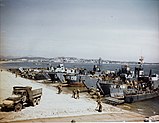
Allied logistics in the Southern France campaign played a key role in the success of Operation Dragoon, the Allied invasion of southern France during World War II. The US Seventh Army landed on the French Riviera on 15 August 1944. Its primary objective was to capture the ports of Marseille and Toulon, preceding a drive northward up the Rhône valley. Both ports fell, but had been badly damaged, so considerable effort was required to bring them into service. The logistics plan gave priority to ammunition during combat loading, anticipating stubborn German resistance. When this proved to not be the case, ammunition had to be moved out of the way in order to reach other materiel, which slowed unloading. To facilitate the advance, engineers repaired bridges, rehabilitated railways and laid pipelines. The Seventh Army continued to draw its supplies from the North African Theater of Operations until it was merged with the Communications Zone of the European Theater of Operations on 20 November. (Full article...)
1,021 characters, including spaces.
SS Politician
SS Politician was a general cargo ship completed in 1923 as London Merchant. She traded between Britain, the United States and Canada, and up and down the west coast of the US. In February 1941, during the Second World War, Politician was on her way to join an Atlantic convoy when she ran aground off the coast of the Hebridean island of Eriskay. Her cargo included 22,000 cases of malt whisky and £3 million worth of Jamaican banknotes. Much of the whisky was recovered by islanders from across the Hebrides, contrary to marine salvage laws. In a series of prosecutions many islanders were found not guilty or not proven, and several were fined; 19 were imprisoned for between 20 days and two months. A few of the banknotes from Politician were presented at banks. As a result, in 1952 the blue ten–shilling notes were replaced with notes printed in purple. The story of the wreck and looting was the basis for the book Whisky Galore; an adaptation was released as a film]in 1949 and a remake in 2016. (Full article...)
1,021 characters, including spaces.
2nd Infantry Division (United Kingdom)
The 2nd Infantry Division was an infantry division of the British Army, first formed in 1809 for service in the Peninsular War. The formation fought at the Battle of Waterloo and played an important role in defeating the final French attack. It was disbanded in December 1818. During the mid to late 19th century, several formations bearing the name 2nd Division were formed, including in 1854 to take part in the Crimean War and in in 1899 for the Second Boer War. From 1902 the division was based at Aldershot, in southern England. When World War I broke out in 1914, it was deployed to France as part of the British Expeditionary Force. The formation served on the Western Front and suffered heavy casualties. The division returned to Aldershot for the interwar period. During World War II, the formation was again deployed to France and evacuated from Dunkirk. It then served in Burma. Post-war it formed part of the British Army of the Rhine in Germany. The division was most recently disbanded in 2012. (Full article...)
1,026 characters, including spaces.
South American dreadnought race
The South American dreadnought race took place in the early twentieth century between Argentina, Brazil and Chile—the most powerful and wealthy countries in South America. In 1906 the revolutionary British warship HMS Dreadnought made all existing battleships obsolete. The Brazilian government ordered three Minas Geraes-class dreadnoughts. These warships would be the most powerful in the world. Economic concerns and a fear that it would be outclassed by even larger super-dreadnoughts led to the incomplete third vessel being sold to the Ottoman Empire in 1913. Meanwhile, the Argentine and Chilean governments ordered two dreadnoughts each: the Rivadavia class in 1910 and Almirante Latorre class in 1911, respectively. The outbreak of World War I ended the naval arms race. The Brazilian super-dreadnought Riachuelo was cancelled; the two Chilean dreadnoughts were purchased by the British; and Argentina's two dreadnoughts were completed in US yards. (Full article...)
975 characters, including spaces.
David (son of Heraclius)
David was one of three co-emperors of the Byzantine Empire for a few months in late 641. David was the son of Emperor Heraclius and his wife and niece Empress Martina. His name was an attempt to link the imperial family with the Biblical David. After the death of Heraclius in February 641 a power struggle ensued. In a compromise, 10-year-old David was raised to co-emperor, alongside his brother Heraclonas and their nephew Constans II. At the time the Byzantine state faced the ongoing Muslim conquest of Egypt and continuing religious strife over monothelitism and other Christological doctrines. All three emperors were children and the Empress Dowager Martina acted as regent. Martina was deeply unpopular due to her incestuous relationship with Heraclius and her unconventional habits. Her regime was deposed, probably by January 642. She and her sons were exiled to Rhodes and, in an early example of Byzantine political mutilation, Martina's tongue was cut out and her sons' noses were cut off. (Full article...)
1,021 characters, including spaces.
Phosphatodraco
Phosphatodraco is a genus of azhdarchid pterosaur that lived during the Late Cretaceous in what is now Morocco. In 2000, a pterosaur specimen consisting of five neck vertebrae was discovered in the Ouled Abdoun Phosphatic Basin. The specimen was made the holotype of the new genus and species Phosphatodraco mauritanicus in 2003. It is one of the only known azhdarchids preserving a relatively complete neck and is one of the last known pterosaurs. Due to the fragmentary nature of the holotype vertebrae, it is unclear how Phosphatodraco is distinguished from other azhdarchids and how large it was: it may have had a wing-span of either 5 m (16 ft) or 4 m (13 ft). Its neck may have been 865 mm (2 ft 10 in) long. It would have had a proportionally long neck, small body, and long limbs, compared to other pterosaurs. The diversity in pterosaur taxa, including Phosphatodraco, in the Ouled Abdoun Basin, right before the Cretaceous–Paleogene extinction event, indicates their extinction happened abruptly. (Full article...)
1,025 characters, including spaces.
Niandra LaDes and Usually Just a T-Shirt
Niandra LaDes and Usually Just a T-Shirt is the debut album by American musician John Frusciante (pictured), released on November 22, 1994, by American Recordings. Frusciante was previously a member of the Red Hot Chili Peppers, but left in 1992 after he became overwhelmed by the band's newfound popularity. During this period, he became severely depressed and developed a serious drug addiction. He isolated himself in his home to record music for an eventual album. Niandra LaDes and Usually Just a T-Shirt combines avant-garde and stream-of-consciousness styles, with guitar, piano and various effects on a four-track recorder. Niandra LaDes and Usually Just a T-Shirt was met with general confusion and a mixed response from fans and critics. David Wild of Rolling Stone wrote: "This is twisted, cool stuff." It sold 15,000 copies by 1996. Two years later, Frusciante rehabilitated and rejoined the Red Hot Chili Peppers. (Full article...)
944 characters, including spaces.
Russian occupations of Beirut
The Russian occupations of Beirut were two separate military actions by squadrons of the Imperial Russian Navy as part of Russia's Levant campaign during the Russo-Turkish War of 1768–1774. In June 1770 a Russian fleet established naval command of the Mediterranean at the battle of Chesma (pictured). In 1772 Russia attempted to assist Egypt's autonomous ruler, Ali Bey al-Kabir, who was in rebellion against the Ottoman Empire. A small Russian squadron helped repel an Ottoman offensive on Sidon, then sailed for Beirut. It bombarded the town and occupied it from June 23 to 28. In June 1773 another Russian squadron accepted an offer by the Druze chieftain Yusuf Shihab to pay the Russians a tribute in exchange for their capturing Beirut. A bombardment of the town began on August 2, and it surrendered on October 10. Several hundred Albanian mercenaries were left as occupiers and kept the Russian flag raised over the town until late January or early February 1774. (Full article...)
989 characters, including spaces.
Battle of the Defile
The Battle of the Defile was fought over three days in July 731 CE in and near the Takhtakaracha Pass (in modern Uzbekistan) between a large army of the Umayyad Caliphate and forces of the Türgesh khaganate. The Türgesh had been besieging Samarkand, and its commander, Sawra ibn al-Hurr al-Abani, sent a request for relief to the newly appointed governor of Khurasan, Junayd ibn Abd al-Rahman al-Murri. Junayd's 28,000-strong army was attacked by the Türgesh in the pass, and although the Umayyad army managed to extricate itself and reach Samarkand, it suffered heavy casualties. Sawra's 12,000 men attacked the Türgesh from the rear in a relief effort and were almost annihilated. The battle halted and even reversed Muslim expansion into Central Asia (map pictured) for a decade. In addition, it increased Khurasani disaffection for the Umayyad regime, and drew away reinforcements from the metropolitan regions of the Caliphate, helping to bring about its downfall twenty years later. (Full article...)
1,014 characters, including spaces.
Betsy Bakker-Nort
Bertha "Betsy" Bakker-Nort was a Dutch feminist, lawyer, and politician who served as a member of the House of Representatives for the Free-thinking Democratic League (VDB) from 1922 to 1942. Born in Groningen, she became involved with the feminist movement in 1894. At age 34, Bakker-Nort started studying law, realising that the fight for women's rights required a thorough understanding of the law. In the 1922 general election, the first in which women were allowed to vote, she was elected to parliament and became the VDB's first female representative. She was re-elected four times and and was an advocate for more women's rights with respect to marriage and labour law. She was also active internationally. After the German invasion of the Netherlands in May 1940, Bakker-Nort did not return to parliament. From December 1942 she was detained in internment and concentration camps. She was liberated in June 1945 and died the following year. (Full article...)
967 characters, including spaces.
Corinna
Corinna was an ancient Greek lyric poet from Tanagra in Boeotia. Although ancient sources portray her as a contemporary of Pindar (born c. 518 BC), not all modern scholars accept this tradition. When she lived has been the subject of much debate since the early twentieth century; proposed dates range from the beginning of the fifth century to the late third century BC. Corinna's works survive only in fragments: three substantial sections of poems are preserved on second-century AD papyri from Egypt; several shorter pieces survive in quotations by ancient grammarians. They focus on local Boeotian legends, and are distinctive for their mythological innovations. Corinna's poetry often reworks popular myths to include details not known from any other sources. Though respected in her hometown, Tanagra, and popular in ancient Rome, modern critics regard her as provincial and dull. Her poetry is nonetheless of interest as the work of one of the few preserved female poets from ancient Greece. (Full article...)
1,010 characters, including spaces.
Happier Than Ever: A Love Letter to Los Angeles
Happier Than Ever: A Love Letter to Los Angeles is a 2021 American concert film directed by Robert Rodriguez and Patrick Osborne, starring singer-songwriter Billie Eilish (pictured). It features performances of all 16 tracks from Eilish's album, Happier Than Ever (2021), at the Hollywood Bowl amphitheater. The films blends live action and animation. Besides directing, Osborne worked on the film's animation, mixing motion capture footage with rotoscoping techniques. The crew produced distinct color palettes and lighting effects for every song. They often recorded Eilish from very close distances, wanting to create a sense of intimacy. The film was released exclusively to Disney+ on September 3, 2021. Critics praised its performances and its animation, cinematography, and setting. It was nominated for Best Austin Film at the 2021 Austin Film Critics Association Awards, Best Music Film at the 64th Annual Grammy Awards, and Best Longform Video at the 2022 MTV Video Music Awards. (Full article...)
1,007 characters, including spaces.
Laika
Laika was one of the first animals in space and the first animal to orbit Earth. A stray mongrel from Moscow, she was selected as the occupant of Sputnik 2 which launched into low orbit on 3 November 1957. The experiment aimed to prove that a living passenger could survive being launched into orbit and endure a micro-g environment, leading to human spaceflight and providing scientists with data on how living organisms react to spaceflight environments. Laika died from overheating, possibly caused by a failure of the central R-7 sustainer to separate from the payload. The true cause and time of her death were not made public until 2002; instead, it was reported that she died when her oxygen ran out on day six or, as the Soviet government initially claimed, she was euthanised prior to oxygen depletion. On 11 April 2008, a monument to Laika was unveiled near the military research facility that prepared her flight to space. She also appears on the Monument to the Conquerors of Space. (Full article...)
1,012 characters, including spaces.
Allied logistics in the Kokoda Track campaign
Allied logistics in the Kokoda Track campaign played a crucial role in bringing the 1942 World War II campaign to a conclusion. To transform Port Moresby, into a major base, engineers built airfields, wharves, roads, and warehouses. The interior was covered with dense rainforest and rugged mountains that wheeled vehicles could not traverse. There were few aircraft available, and they were restricted by the mountains and the weather, and subject to destruction on the ground by Japanese air raids. The loss of the airstrip at Kokoda led to the adoption of airdropping. Due to a shortage of parachutes, supplies were often dropped without them, with attendant losses and breakages. Trucks, jeeps, and pack animals carried stores, ammunition and rations only part of the way. The rest of the journey over the Kokoda Track was on the backs of Papuan carriers, who struggled over the mountains lugging heavy loads, and often carrying the wounded too, which earning the sobriquet of "Fuzzy Wuzzy Angels". (Full article...)
1,020 characters, including spaces.
Homo antecessor
Homo antecessor (Latin for "pioneer man") is an archaic human species which lived from 1.2 to 0.8 million years ago during the Early Pleistocene. Fossils have been found at Sierra de Atapuerca in Spain, the first in 1994. The species was formally described in 1997. Despite being so ancient, the face is unexpectedly similar to that of modern humans rather than other archaic humans, although it is known only from a juvenile specimen. Brain volume could have been 1,000 cc (61 cu in) or more, compared with a present-day human average 1,270 cm3 for males and 1,130 cm3 for females. Stature estimates range from 162.3–186.8 cm (5 ft 4 in – 6 ft 2 in). The feet indicate H. antecessor walked differently from modern humans. H. antecessor manufactured simple pebble and flake stone tools out of quartz and chert, although they used a variety of materials. Many of the H. antecessor specimens found were cannibalised, perhaps as a cultural practice. There is no evidence they used fire. (Full article...)
1,001 characters, including spaces.
Shannon Lucid
Shannon Lucid is an American biochemist and retired NASA astronaut. Lucid earned her bachelor's degree in chemistry in 1963, master's degree in biochemistry in 1970 and PhD in biochemistry in 1973. In 1978, she was recruited by NASA for astronaut training in the first class to include women. She flew on STS-51-G, STS-34, STS-43, STS-58, and completed a six-month mission aboard the Russian Mir in 1996, traveling there on the Space Shuttle Atlantis with STS-76 and returning with STS-79. Lucid is the only American woman to have stayed on Mir. She held the record for the longest duration stay in space by an American and by a woman from 1996 to 2007. She was awarded the Congressional Space Medal of Honor in December 1996, making her the tenth person and first woman accorded this honor. She was the NASA Chief Scientist from 2002 to 2003 and a capsule communicator at Mission Control for numerous Space Shuttle missions, including STS-135, the final one. Lucid announced her retirement from NASA in 2012. (Full article...)
characters, including spaces.
Banjo-Kazooie: Nuts & Bolts
Banjo-Kazooie: Nuts & Bolts is a 2008 platform game developed by Rare and published by Microsoft Game Studios for the Xbox 360 (pictured). Set eight years after Banjo-Tooie (2000), Nuts & Bolts follows Banjo and Kazooie as they compete with the witch Gruntilda for their homeland Spiral Mountain. The game was developed by the same team behind the Nintendo 64 Banjo games. It began as a remake of Banjo-Kazooie (1998) but was repurposed as an original game. Nuts & Bolts was released in November 2008, drawing criticism from fans for departing from the Banjo-Kazooie gameplay, but receiving generally positive reviews. It was a commercial disappointment, but its reputation has since improved. Its focus on construction and player freedom are considered ahead of its time, predating popular games such as Minecraft (2011) and Fallout 4 (2015). It remains the most recent Banjo-Kazooie game, despite fan interest in a continuation. (Full article...)
948 characters, including spaces.
Ibn al-Ash'ath
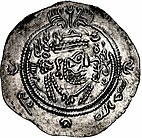
Abd al-Rahman ibn Muhammad ibn al-Ash'ath was an Arab nobleman and military commander during the Umayyad Caliphate. Ibn al-Ash'ath played a minor role in the Second Fitna and then served as governor of Rayy. After the appointment of al-Hajjaj as governor of Iraq in 694, relations with the Iraqi tribal nobility became strained. In 699, al-Hajjaj appointed Ibn al-Ash'ath as commander of a huge Iraqi army to subdue Zabulistan. In 700, Ibn al-Ash'ath and the army to revolted. This developed into a full-fledged anti-Umayyad rebellion, with widespread support, especially among the religious zealots known as "Quran readers". The rebel army was decisively defeated by al-Hajjaj's Syrian troops at the Battle of Dayr al-Jamajim. Ibn al-Ash'ath fled to Zabulistan. His fate is unclear, some accounts hold that he was executed there, while most claim that he committed suicide to avoid capture. The suppression of Ibn al-Ash'ath's revolt signalled the end of the power of the tribal nobility of Iraq. (Full article...)
1,015 characters, including spaces
Theodora Kroeber
![]()
Theodora Kroeber was an American writer and anthropologist, best known for her accounts of Native Californian cultures. She grew up in the mining town of Telluride, and worked briefly as a nurse. She graduated with a major in psychology in 1919, and received a master's degree in 1920. Married in 1920 and widowed in 1923, she began doctoral studies in anthropology. She met anthropologist Alfred Kroeber and married him in 1926. One of her two children with Kroeber was the writer Ursula K. Le Guin. Kroeber began writing professionally late in life, publishing a collection of translated Native Californian narratives in 1959. Two years later she published Ishi in Two Worlds, an account of the last member of the Yahi people of Northern California. This sold widely, and received high praise from contemporary reviewers. In 1960, Theodora married artist John Quinn. She published several other works. A 1989 biography stated that her "great strength was as an interpreter of one culture to another". (Full article...)
1,020 characters, including spaces.
Denbies
Denbies is an estate near Dorking in Surrey, England. A farmhouse and surrounding land was converted into a weekend retreat in 1734. In 1849 it passed to Thomas Cubitt, a master builder, working at the time on the royal residence Osborne House. He designed a mansion at Denbies as a more modest version of Osborne. It was a substantial building in the Italianate style, with almost 100 rooms on three storeys. The payment of death duties and the maintainence of a large domestic estate forced the family to begin selling parcels of land. Cubitt's mansion was abandoned until its demolition in 1953, by which time the family was living in a Regency-style house converted from the housing of the garden and stable staff. The 635 acres (2.57 km2) left of the estate was put on the market in 1984 and bought by Biwater, a water-treatment company. Two years later the company chairman Adrian White established Denbies Wine Estate, using 268 acres (1.08 km2) on a south-facing piece of land to plant vines. (Full article...)
1,018 characters, including spaces.
Corp Naomh
![]()
The Corp Naomh (English: Holy or Sacred Body) is an Irish bell shrine made in the 9th or 10th century to enclose a now lost hand-bell, which probably dated to c. 600 to 900 AD and belonged to an early Irish saint. It is 23 cm (9.1 in) high and 12 cm (4.7 in) wide. It consists of cast and sheet bronze plates mounted on a wooden core decorated with silver, niello and rock crystal. It is severely damaged with extensive losses and wear across almost all of its parts. Sections from its original include the cross on the reverse and the ornate semi-circular cap, which shows a bearded cleric holding a book. He is surrounded on both sides by horsemen and large birds. It was extensively refurbished in the 15th and possibly the 16th centuries when a central bronze crucifixion of Jesus, a griffin and lion panel, stamped border panels and a backing plate were added. It has been displayed in the National Museum of Ireland since 1887. (Full article...)
951 characters, including spaces.
HMS Argus (I49)
![]()
HMS Argus was a British aircraft carrier that served in the Royal Navy from 1918 to 1944. She was converted from an ocean liner and became the first example of the standard pattern of aircraft carrier, with a full-length flight deck allowing aircraft to take off and land. The ship was involved for several years in the development of the optimum design for other aircraft carriers. She spent one brief deployment on the China Station in the late 1920s before being placed in reserve. Argus was recommissioned and partially modernised shortly before the Second World War. In July 1940 she made the first of her many ferry trips to fly off fighters to Malta. In 1942 she was pressed into front-line service despite her lack of speed and armament. She provided air cover during the invasion of French North Africa and was slightly damaged by a bomb. Argus was used again for deck-landing practice until September 1944. In December she became an accommodation ship, was sold in late 1946 and scrapped in 1947. (Full article...)
1,025 characters, including spaces.
Boring Lava Field
![]()

The Boring Lava Field is a Plio-Pleistocene volcanic field with cinder cones, small [[shield volcano[[es, and lava flows in the northern Willamette Valley of the U.S. states of Oregon and southwest Washington. The zone became active about 2.7 million years ago, with long periods of eruptive activity interspersed with quiescence. Its last eruptions took place about 57,000 years ago; individual volcanic vents are considered extinct, but the field itself is not. The volcanic field covers an area of about 1,500 square miles (3,900 km2), and has a total volume of 2.4 cubic miles (10 km3). The highest elevation of the field is at Larch Mountain, which reaches a height of 4,055 feet (1,236 m). The Portland metropolitan area, including suburbs, is one of the few places in the continental United States to have extinct volcanoes within a city's limits. The probability of future eruptions affecting the Portland–Vancouver metropolitan area is very low. (Full article...)
972 characters, including spaces.
Project Waler
Project Waler was an unsuccessful Australian defence procurement exercise which sought to replace the Australian Army's M113 armoured personnel carriers during the mid-1990s with between 500 and 1,000 armoured fighting vehicles optimised for Australian conditions. The vehicles were to be built in Australia to support the local manufacturing industry. After initial scoping work in 1980, proposals were submitted in 1982, and further studies were undertaken during 1983. A planned tender to acquire them was not issued. Instead, Project Waler was cancelled by the Australian Government in July 1985 due to concerns over the cost and capabilities of the proposed vehicles. Most of the M113s were upgraded, although the resultant vehicles were unfit for combat, and the Australian Government launched a new project in 2018 to replace them. Commentators have noted that Project Waler was over-ambitious, with not enough emphasis placed on keeping costs down. (Full article...)
974 characters, including spaces.
Galton Bridge
The Galton Bridge is a cast-iron bridge in Smethwick, near Birmingham, in central England. It was built by Thomas Telford to carry a road across the new main line of the Birmingham Canal, which was built in a deep cutting. The bridge is 70 ft (21 m) above the canal, making it reputedly the highest single-span arch bridge in the world when it was built, 26 ft (7.9 m) wide, and 150 ft (46 m) long. The Galton Bridge was forged at the nearby Horseley Ironworks, and has masonry abutments. The design includes decorative lamp-posts and X-shaped bracing in the spandrels. In the 1840s, a railway bridge was built from one of the abutments, with a parapet in keeping with the original. The Galton Bridge carried traffic for over 140 years until it was bypassed by a new road in the 1970s, and now only carries pedestrians and cyclists. The bridge is one of six built by Telford that share common design features and the only one still standing without modification. It is a grade I listed building. (Full article...)
1,103 characters, including spaces.
Nassau class battleship

The Nassau class was a group of four dreadnought battleships built for the Imperial German Navy in the mid-1900s. The class comprised Nassau, Rheinland, Posen, and Westfalen. All four were laid down in mid-1907, and completed by late 1910. The Nassaus adopted a main battery of twelve 28 cm (11 in) guns in six twin-gun turrets. The four ships served as II Division, I Battle Squadron of the High Seas Fleet for the duration of their careers. From 1910 to 1914, the ships participated in squadron exercises, training cruises, and fleet maneuvers. During World War I, the ships took part in operations intended to isolate and destroy parts of the numerically superior British Grand Fleet. These culminated in the Battle of Jutland in 1916, where the ships helped to sink the armored cruiser HMS Black Prince. The ships also saw service in the Baltic Sea against the Russian Empire. After the war, all four ships were ceded to the Allied powers and broken up. (This article is part of a featured topic: Battleships of Germany.)
1,025 characters, including spaces.
First Battle of Newtonia
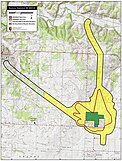
The First Battle of Newtonia was fought on September 30, 1862 between Confederate soldiers commanded by Colonel Douglas H. Cooper and a Union column commanded by Brigadier General Frederick Salomon near Newtonia, Missouri, during the American Civil War. A Union advance force attacked Cooper's position in Newtonia during the morning of September 30. Both sides brought up reinforcements, and seesaw fighting took place during the afternoon. Shortly before nightfall the Confederates made an all-out attack and the Union forces withdrew. Confederate artillery fire struck them, turning the retreat into a disorderly rout. Union casualties are reported as either 245 or over 400, while Confederate losses were 78. Blunt's whole division advanced towards Newtonia in early October, leading Cooper to abandon Missouri. A portion of the battlefield (pictured) was listed on the National Register of Historic Places in 2004 as the First Battle of Newtonia Historic District. (Full article...)
987 characters, including spaces.
13th Missouri Cavalry Regiment (Confederate)
The 13th Missouri Cavalry Regiment was a cavalry regiment that served in the Confederate States Army during the American Civil War. The unit originated in early April 1863, when Captain Robert C. Wood, aide-de-camp to Confederate Major General Sterling Price, was detached to form an artillery unit from some of the men of Price's escort. Wood continued recruiting for the unit, which was armed with four Williams guns, and had 275 men by the end of September. The next month, the unit participated in the Battle of Pine Bluff, where it drove back Union Army troops into a barricaded defensive position, from which the Union soldiers could not be dislodged. By November, the unit, which was known as Wood's Missouri Cavalry Battalion, had grown to 400 men but no longer had the Williams guns. In April 1864, Wood's battalion, which was also known as the 14th Missouri Cavalry Battalion, played a minor role in the defeat of a Union foraging party in the Battle of Poison Spring. After spending the summer of 1864 at Princeton, Arkansas, Wood's battalion was part of a force Price took into the state of Missouri during Price's Raid. Price's force entered the state in September, and the unit made an unsuccessful assault during the Battle of Pilot Knob on September 27.
Wood's battalion fought at the Battle of Little Blue River on October 21 after having fought in some further fighting and operations against railroads. Two days later, Price's army was defeated at the Battle of Westport, and began retreating through the state of Kansas. During the retreat, on October 25, Wood's battalion was part of the Confederate line when it was shattered at the Battle of Mine Creek. During that action, the unit suffered 72 casualties, 50 of them as prisoners of war. It then accompanied Price's army to Laynesport, Arkansas, via the Indian Territory and Texas. At an unknown date, it was enlarged to regimental strength and renamed the 13th Missouri Cavalry Regiment. After Price's Raid, the unit spent the rest of the war serving outpost duty in Arkansas. The Confederate commander of the Trans-Mississippi Department surrendered on June 2, 1865, and the men of the 13th Missouri Cavalry Regiment were paroled six days later. Around 670 men served in the unit over the course of its existence, at least 67 of whom died during that time. (Full article...)
characters, including spaces.
1,021 characters, including spaces.
Theodoros II Laskaris
Theodore II Laskaris (1221/1222 – 16 August 1258) ruled the Empire of Nicaea from 1254 to 1258. Nicaea was a successor state to the Byzantine Empire, after crusaders captured the Byzantine capital, Constantinople in 1204 during the Fourth Crusade. Theodore began to write treatises on theological, historical and philosophical themes in his youth. From around 1242, he was co-ruler with his father and his relationship with some prominent aristocrats grew tense. Succeeding his father in 1254 Theodore dismissed many aristocratic officials and generals, replacing them with loyalists, including some of low birth. In 1256, he repelled a Bulgarian invasion of Thrace and Macedonia and forced Epirus, to cede Dyrrachium on the Adriatic Sea. Epirus forged an alliance with Serbia and Sicily against Nicaea, and its new generals could not resist their joint invasion in 1257. Theodore died in 1258, leaving an underage son, John IV. Michael Palaiologos seized the regency, and usurped the throne soon after. (Full article...)
1,022 characters, including spaces.
Adamson Tannehill
Adamson Tannehill (May 23, 1750 – December 23, 1820) was an American military officer, politician, civic leader, and farmer. Born in Maryland, Tannehill was among the first to join the Continental Army during the American Revolutionary War, becoming commander of the Maryland and Virginia Rifle Regiment. He then settled in Pittsburgh, Pennsylvania, where he was active in the state militia, rising to the rank of major general in 1811. Tannehill held several local, state, and national offices, including one term as a Democratic-Republican in the U.S. House of Representatives from 1813 to 1815. He was president of the Pittsburgh branch of the Bank of the United States from 1817 until his death. He also served on the founding boards of several civic and state organizations. Tannehill died in 1820 and was buried at his Grove Hill home outside Pittsburgh. He was later reinterred in Allegheny Cemetery (gravestone pictured). (Full article...)
944 characters, including spaces.
Hove War Memorial
Hove War Memorial is a First World War memorial designed by Sir Edwin Lutyens and located on Grand Avenue in Hove, part of the city of Brighton and Hove, on the south coast of England. Hove was the site of one of the earliest recruiting events at the beginning of the war and later of several military hospitals. Over 600 men from the town were killed during the war. A war memorial committee was established in 1919 and Lutyens was engaged as architect. He designed a Tuscan column on a three-staged base, topped with a statue of Saint George, patron saint of England. George, cast in the studio of Sir George Frampton, holds a sword by the blade in one hand and a shield in the other. The same statue, with variations, appears on several other monuments. The base contains several dedicatory inscriptions but no names, which are instead recorded on plaques in the town's library. The memorial was unveiled on 27 February 1921 by Lord Leconfield. It is a grade II listed building. (Full article...)
999 characters, including spaces.
Battle of the Trebia
The battle of the Trebia was the first major battle of the Second Punic War, fought between the Carthaginian forces of Hannibal and a Roman army under Sempronius Longus on 22 or 23 December 218 BC. Each army had a strength of about 40,000 men; the Romans were stronger in infantry, the Carthaginians in cavalry and they fielded about 30 war elephants. Hannibal used his Numidian cavalry to lure the Romans out of their camp and onto ground of his choosing. Fresh Carthaginian cavalry routed the outnumbered Roman cavalry and Carthaginian light infantry outflanked the Roman infantry. A previously hidden Carthaginian force attacked the Roman infantry in the rear. Most of the Roman units then collapsed and most Romans were killed or captured by the Carthaginians, but 10,000 under Sempronius maintained formation and fought their way out to the safety of Placentia. The following spring the Carthaginians moved south into Roman Italy and operated there for 15 years. (Full article...)
985 characters, including spaces.
Florence Petty
Florence Petty was a Scottish cookery writer and broadcaster. During the 1910s Petty undertook social work in Somers Town, north London, running demonstrations for working-class women of how to cook inexpensive and nutritious foods. Much of the instruction was done in the women's homes. Petty wrote on cookery, publishing works aimed at those also involved in social work, and a cookery book and a pamphlet aimed at the public. From 1914 until the mid-1940s she toured Britain giving lecture-demonstrations of cost-efficient and nutritious ways to cook, including dealing with food shortages during the First World War. In the late 1920s and early 1930s, she was a broadcaster on food and budgeting for the BBC. Petty continued to work until her death in 1948 at the age of 77. She is considered to be a pioneer of social work innovations. Her approach to teaching the use of nutritious but cheap food was a precursor to the method adopted by the Ministry of Food during the Second World War. (Full article...)
1,011 characters, including spaces.
Pope Sisinnius
Pope Sisinnius was the bishop of Rome from 15 January 708 to his death on 4 February, succeeding John VII. Besides the fact that he was Syrian and his father was named John, little is known of Sisinnius' early life or career. At the time of his election to the papal throne, Sisinnius suffered from severe gout, leaving him weak. During the course of his twenty-day papacy, Sisinnius consecrated a bishop for Corsica and ordered the reinforcement of the walls surrounding the papal capital of Rome. The popes of the time were not able to appoint all bishops, nor were they able to govern the universal Church. They did not publish encyclicals or catechisms, and were not able to canonize saints or convene ecumenical councils. Like many of his immediate predecessors, Sisinnius was likely not a member of the upper class, but he was respected for his upright, moral disposition and concern for the people of Rome. On his death in Rome, Sisinnius was buried in Old St. Peter's Basilica. He was succeeded by Pope Constantine. (Full article...)
1,041 characters, including spaces.
French battleship Bouvet
Bouvet was a pre-dreadnought battleship of the French Navy, built in the 1890s. She was armed with a main battery of two 305 mm (12 in) guns and two 274 mm (10.8 in) guns in individual turrets. With a top speed of 18 knots (33 km/h; 21 mph) she was one of the fastest battleships in the world. Bouvet spent the majority of her peacetime career in the Mediterranean Squadron conducting routine training exercises and was removed from front-line service in 1907. At the start of World War I in 1914, Bouvet operated uneventfully in the western Mediterranean. She then joined the Dardanelles campaign, attacking Ottoman fortifications. During an assault on 18 March 1915 Bouvet was hit eight times by shellfire without serious damage. While withdrawing she struck a mine and sank within two minutes; only 75 men were rescued from a complement of 718. Two British battleships were also sunk by mines. These losses convinced the Allies to abandon the naval campaign in favor of an amphibious assault. (Full article...)
1,013 characters, including spaces.
Niels Bohr
Niels Bohr was a Danish physicist who created the first widely accepted model of atomic structure. In three articles published in 1913, he applied old quantum theory to restrict the revolving electrons to stable orbits, creating the Bohr model of the atom. Faced with the opposing particle and wave interpretations of atomic phenomena in the new quantum mechanics, he proposed the complementarity principle of using both interpretations to fully explain the results. Bohr received the Nobel Prize in Physics in 1922. He founded the Institute of Theoretical Physics in Copenhagen, now known as the Niels Bohr Institute. He correctly predicted the existence of a new element, hafnium. Later, the element bohrium was named after him. During the 1930s, he helped refugees from Nazism and in September 1943 fled to Britain to avoid arrest by the Germans. There he joined the Tube Alloys nuclear weapons project, and later the Manhattan Project. After the war, Bohr was involved with the establishment of CERN. (Full article...)
1,022 characters, including spaces.
Yugoslav torpedo boat T1
T1 was a seagoing torpedo boat that was operational between 1914 and 1955. She was built as 76 T for the Austro-Hungarian Navy, and armed with two 66 mm (2.6 in) guns and four 450 mm (17.7 in) torpedo tubes, and could carry 10–12 naval mines. During World War I she performed convoy, escort and minesweeping tasks, anti-submarine operations and shore bombardment missions. Following Austria-Hungary's defeat in 1918 she and seven other 250t-class boats were allocated to the Royal Yugoslav Navy, its only modern sea-going vessels. Renamed T1 the ship was involved in training exercise and cruises. She was captured by the Italians during the Axis invasion of Yugoslavia in April 1941 and served with the Royal Italian Navy. Following the Italian capitulation in September 1943, she was returned to the Yugoslav Navy. After World War II she was refitted and served as Golešnica until 1955. She was sunk as a target ship in the Bay of Kotor, and is now a recreational dive site. (Full article...)
994 characters, including spaces.
Ohmdenosaurus
Ohmdenosaurus is a genus of sauropod dinosaur that lived during the Early Jurassic epoch in what is now Germany. The only specimen – a tibia (shinbone) and ankle – was discovered in rocks of the Posidonia Shale near the village of Ohmden. The specimen is exhibited in a local museum and in the 1970s the German palaeontologist Rupert Wild recognised it as the remains of a sauropod. One of the earliest known sauropods, Ohmdenosaurus was quadrupedal (four-legged) and already had the columnar limbs typical for the group. It was small for a sauropod, with an estimated length of 3–4 m (10–13 ft). Its relationships to other sauropods remain uncertain due to the incompleteness of its remains. The Posidonia Shale was deposited within a shallow inland sea; Ohmdenosaurus was a terrestrial animal, and its carcass must have been transported by predators or water currents at least 100 km (62 mi) from the shoreline to its site of burial. It is the only dinosaur fossil known from the shale. (Full article...)
1,006 characters, including spaces.
Temple of Apollo Palatinus
The Temple of Apollo Palatinus was a temple to the god Apollo in Rome, constructed on the Palatine Hill on the initiative of Augustus between 36 and 28 BCE. It was associated with Augustus's victories at the battles of Naulochus and Actium; the latter was extensively memorialised through its decoration. The temple represented the restoration of Rome's golden age and Augustus's devotion to religious and political duty. Its precinct was used for diplomatic functions and meetings of the Roman Senate. Augustan poets frequently mentioned and praised the temple, and its lavish artistic decoration and statuary in their works. The temple was destroyed in a fire in 363 CE, which was rumoured to be an act of arson committed by Christians. The incomplete remains of the temple has been excavated and partially restored. Modern assessments of the temple have variously treated it as a Hellenising break with Roman tradition and as a conservative attempt to reassert the values of the Roman Republic. (Full article...)
1,015 characters, including spaces.
TRAPPIST-1

TRAPPIST-1 is a cool red dwarf star with seven known exoplanets. It lies in the constellation Aquarius about 40.66 light-years away from Earth. It has a mass of about 9% of the Sun. It is estimated to be 7.6 billion years old, making it older than the Solar System. The discovery of the star was first published in 2000. Observations in 2016 from the Transiting Planets and Planetesimals Small Telescope (TRAPPIST) led to the discovery of two orbiting terrestrial planets, and five others of unknown types. It takes the seven planets between about 1.5 and 19 days to orbit around the star. They are likely tidally locked to TRAPPIST-1, leading to permanent day on one side and night on the other. Their masses are comparable to that of Earth. Up to four of the planets orbit at distances where temperatures are suitable for the existence of liquid water, and are thus potentially hospitable to life. This has drawn interest from both researchers and popular culture. (Full article...)
979 characters, including spaces.
British logistics in the Siegfried Line campaign

British logistics supported the Anglo-Canadian forces in the Western Allied invasion of Germany, the final campaign of the Second World War in Europe. By this time, the 21st Army Group was highly experienced, professional and proficient. To conserve manpower, mechanisation and materiel were used to maximum effect. The First Canadian Army was reunited by the return of divisions from Italy. The army roadheads were mainly supplied by rail; fuel was brought by tankers and the Operation Pluto pipeline. Thousands of guns and millions of rounds of ammunition were used in Operation Veritable, the advance to the Rhine, and Operation Plunder, the Rhine crossing, which also featured an airborne operation. Engineers soon had bridges in operation. During April 1945, the 21st Army Group advanced across northern Germany to reach the Elbe and then the Baltic. On 4 May, Field Marshal Sir Bernard Montgomery took the surrender of the German forces in front of the 21st Army Group. (Full article...)
993 characters, including spaces.
Revolutionary Girl Utena
Revolutionary Girl Utena is a Japanese anime television series that originally aired on TV Tokyo in 1997. The director, Kunihiko Ikuhara, frustrated by the lack of creative control with adapted works, developed it as an original series. It follows Utena Tenjou, a teenaged girl drawn into a sword dueling tournament to win the hand of a mysterious girl who possesses the "power to revolutionize the world". Revolutionary Girl Utena has been described as a deconstruction and subversion of fairy tales and the magical girl genre of shōjo manga, making heavy use of allegory and symbolism to comment on themes of gender, sexuality, and coming-of-age. Its visual and narrative style is characterized by a sense of theatrical presentation and staging. The series received domestic and international critical acclaim, and many accolades. It has been praised for its treatment of LGBT themes, and has influenced subsequent animated works. In 1999 the film Adolescence of Utena was produced as a follow-up. (Full article...)
1,016 characters, including spaces.
Sarcophagus of Eshmunazar II
The sarcophagus of Eshmunazar II dates to the 6th-century BC and was unearthed in 1855 near Sidon, in modern-day Lebanon. It contained the body of a Phoenician king of Sidon and is one of only three Ancient Egyptian sarcophagi found outside Egypt. It was likely carved in Egypt from local amphibolite and captured during Cambyses II's conquest of Egypt in 525 BC. The sarcophagus has two sets of Phoenician inscriptions, one on its lid and a partial copy around the curvature of the head. This was the first Phoenician language text to be discovered in Phoenicia proper and the most detailed found to that point. More than a dozen scholars rushed to translate it, noting the similarities between the Phoenician language and Hebrew. The translation allowed them to identify the king buried inside, his lineage, and his construction feats. The inscriptions also warn against disturbing Eshmunazar II's place of repose. Today the sarcophagus is one of the highlights of the Louvre's Phoenician collection. (Full article...)
1,021 characters, including spaces.
Dark Archives
Dark Archives is a non-fiction book by the medical librarian and death-positive advocate Megan Rosenbloom. Dealing with anthropodermic bibliopegy, the binding of books in human skin, it expounds upon Rosenbloom's research on such books and their historical, ethical, and cultural implications. Rosenbloom discusses how anthropodermic bibliopegy reflects changing attitudes towards consent, ownership, and disposal of human bodies, and how the history of such books intertwines with the history of medical ethics as a field. She examines notable examples of anthropodermic bibliopegy and their origins, and interviews librarians, archivists, collectors, and experts on the topic. Though Rosenbloom supports the preservation and maintenance of anthropodermic books, Dark Archives also covers arguments to the contrary. The book was published by Farrar, Straus and Giroux in 2020 and critics praised it for its thorough research, clear writing, and enthusiasm for rare books and their history. (Full article...)
1,008 characters, including spaces.
Smoking on My Ex Pack
"Smoking on My Ex Pack" is a song by American singer-songwriter SZA (pictured) from her second studio album, SOS (2022). It is one of the album's three rap tracks, built around hard-hitting drums and a sped-up sample of a 1980s ballad. Before the album's release, SZA was viewed as an R&B artist who made music for "sad girls": melancholic music aimed at a female audience. Disillusioned, she conceived "Smoking on My Ex Pack", among other songs, to combat such narratives, which she believed was stereotyping of her as a Black woman. With the track, she experimented with more lyrically and sonically aggressive music, making a foray into hip hop. "Smoking on My Ex Pack" speaks positively of her own sex appeal and negatively of her ex-lovers, reveling in SZA's braggadocious, taunting persona: one lover has his penis ridiculed. Critics were positive about the new sound, and they deemed the lyrics candid and scathing enough that she had the potential to become a fully fledged rapper. (Full article...)
1,015 characters, including spaces.
Elizabeth Maitland, Duchess of Lauderdale
Elizabeth Maitland was a Scottish noblewoman, the eldest daughter of William Murray and his wife Catherine, the Earl and Countess of Dysart. She was raised in English court circles and received a well-rounded education. Her first husband was Lionel Tollemache, by whom she had eleven children. In 1672, three years after Lionel's death, she married John Maitland. After her father's death Elizabeth held the title of Countess of Dysart in her own right and from her remarriage she was also the Duchess of Lauderdale. She was famous for the political influence she exercised and for her support for Charles II during his exile. As a member of the secret Royalist organisation known as the Sealed Knot, she actively supported the return of the monarchy after the execution of Charles I. She was also a lifelong patron of artists, particularly Peter Lely. She died at the age of 71 at her family home, Ham House near Richmond, and is buried in the nearby parish church. (Full article...)
985 characters, including spaces.
Rodrigues night heron
The Rodrigues night heron is an extinct species of heron that was endemic to the Mascarene island of Rodrigues. It was first mentioned in two 1600s and 1700s accounts, and these were correlated with subfossil remains found and described in the latter part of the 19th century. The Rodrigues night heron was robust, its bill was comparatively large, stout and straight, and its legs were short and strong. It is estimated to have been 60 cm (24 in) long, and its appearance in life is uncertain. Little is known about its behaviour, but the contemporary accounts indicate that it ate lizards, was adapted to running, and although able to fly, rarely did so. Examinations of the known remains have confirmed its terrestrial adaptations; one researcher thought the species flightless but this idea has not been accepted by others. The species could not be found by 1763, and it is thought to have been driven to extinction by human-related factors such as the introduction of cats. (Full article...)
997 characters, including spaces.
Micronations and the Search for Sovereignty
Micronations and the Search for Sovereignty is a non-fiction book about micronations and their legal status within international law. It is written by the Australian lawyers and legal academics Harry Hobbs (pictured) and George Williams, both of whom specialise in international law. Written from an academic perspective, it is one of few works on micronational movements. The book concerns the definition of statehood, the place of micronations within international law, people's motivations for declaring them, the micronational community, and the ways by which such entities mimic sovereign states. It was published by Cambridge University Press as an ebook on 23 December 2021, and in hardcover and paperback formats in January 2022. The work's legal and non-dismissive academic approach to micronations garnered positive reviews. Hobbs and Williams authored a subsequent publication for a broader audience, entitled How to Rule Your Own Country: The Weird and Wonderful World of Micronations, published in 2022. (Full article...)
1,023 characters, including spaces.
Titanis
Titanis is a genus of phorusrhacid, an extinct family of large, predatory birds, in the order Cariamiformes. The first fossils were unearthed in Florida and were named Titanis walleri in 1963. The holotype material is fragmentary – only an incomplete right tarsometatarsus (lower leg bone) and phalanx (toe bone) – but comes from one of the largest phorusrhacid individuals known. Titanis had elongated hind limbs, a thin pelvis, proportionally small wings, and a large skull with a hooked beak. A 2005 estimate placed Titanis at 2 to 2.5 meters (6.6 to 8.2 ft) in height and 200 kilograms (440 lb) in weight. Titanis was likely one of several apex predators in its ecosystem. Titanis is known from the Pliocene deposits of Florida, southern California, and southeastern Texas, which had large open savannas and a menagerie of mammalian megafauna. Titanis is unique among phorusrhacids as the only one known from North America, crossing over from South America during the Great American Interchange. (Full article...)
1,013 characters, including spaces.
44th Chess Olympiad
The 44th Chess Olympiad was an international team chess event organised by the International Chess Federation (FIDE) in Chennai, India in 2022. This was the first chess olympiad to take place in India. The main venue was the convention centre at the Four Points by Sheraton. There were 937 participants in the open tournament and 800 in the women's event. Teams represented 186 nations in the open section and 160 in the women's. Both sections set team participation records. Uzbekistan won the gold medal in the open event, while Ukraine claimed gold in the women's event. English player David Howell had the highest performance for an individual player in the open event with a performance rating of 2898, scoring 7½ out of a possible 8 points. Polish player Oliwia Kiołbasa had the highest individual performance in the women's event with a performance rating of 2565, with 9½ of a possible 11 points. The 93rd FIDE Congress took place during the Olympiad. (Full article...)
977 characters, including spaces.
Jessie Murray
Jessie Murray (1867–1920) was a British psychoanalyst and suffragette who studied medicine at the University of Durham and University College London. Murray and her close friend Julia Turner opened the Medico-Psychological Clinic in 1913, a pioneering entity that provided psychological evaluation and treatment, affordable for middle-class families. Several of the staff who worked and trained at the clinic became leading psychoanalysts. The clinic closed in 1922, although it laid the foundation of psychological evaluation in the UK. Murray was a member of the Women's Freedom League and the Women's Tax Resistance League, two organisations that took direct action for women's suffrage. In 1910 she and the journalist Henry Brailsford took statements from the suffragettes who had been mistreated during the Black Friday demonstrations. Their memorandum was published, with a formal request for a public inquiry. The Home Secretary, Winston Churchill, refused to establish one. (Full article...)
1,001 characters, including spaces.
Quine–Putnam indispensability argument
The Quine–Putnam indispensability argument claims that we should believe in abstract mathematical objects such as numbers and sets because mathematics is indispensable to science. One of the most important ideas in the philosophy of mathematics, it is credited to W. V. Quine and Hilary Putnam (pictured). The roots of the argument can be traced back to thinkers such as Gottlob Frege and Kurt Gödel, but Quine introduced its key components, including naturalism and confirmational holism. Putnam gave Quine's argument its first detailed formulation, although he later expressed disagreement with some aspects of the argument. Many counterarguments have been raised against the idea. An influential argument by Hartry Field claims that mathematical entities are dispensable to science. Other philosophers, such as Penelope Maddy, have argued that we do not need to believe in all of the entities that are indispensable to science. (Full article...)
944 characters, including spaces.
Logic

Logic is the study of correct reasoning. Formal logic aims to determine the correctness of arguments based on their structure alone and often uses a formal language to analyze them. Informal logic examines arguments expressed in natural language and also takes their content and context into account. Logic distinguishes between deductive, inductive, and abductive arguments. Deductive arguments have the strongest form of support: if their premises are true then their conclusion must also be true, like in the argument "it's Sunday; if it's Sunday then I don't have to work; therefore I don't have to work today". Inductive arguments are generalizations, like inferring that all ravens are black based on many individual observations. Abductive arguments are inferences to the best explanation, for instance, when a doctor concludes that a patient has a certain disease that explains the symptoms they suffer. Arguments that fall short of the standards of correct reasoning embody fallacies. (Full article...)
1,010 characters, including spaces.
Asimov's Science Fiction
Asimov's Science Fiction is an American science fiction magazine, edited by Sheila Williams (pictured) since 2004. It was launched in 1977 under the title Isaac Asimov's Science Fiction Magazine, and was quickly successful, reaching a circulation of over 100,000 within a year. George H. Scithers, the first editor, published many new writers who went on to be successful in the genre. Shawna McCarthy became the editor in 1983, and expanded the range of stories Asimov's was willing to publish. Stories involving sex or violence scandalized some readers, but Isaac Asimov, the editorial director, defended McCarthy's choices in an editorial. McCarthy transformed the magazine into a leading market for science fiction writers, and more award-winning stories appeared, including fiction by Robert Silverberg and John Varley. Gardner Dozois took over as editor in 1985 and multiple award-winning stories appeared during his tenure. Asimov's was acquired by Dell Magazines in 1992, and by Penny Press in 1996. (Full article...)
1,024 characters, including spaces.
1896 Summer Olympics
The 1896 Summer Olympics were the first Olympic Games since the Ancient Olympic Games were cancelled by Roman Emperor Theodosius I in 393. A 1894 congress organized by Pierre de Coubertin in Paris established the International Olympic Committee and appointed the Greek capital Athens as the host city. The Greeks had little experience of organizing sports events and initially experienced financial difficulties, but managed to have everything ready in time. The games took place from from 6 to 15 April 1896, fourteen nations took part, and 241 athletes, all male, gave it the largest international participation for any sports event to that date. The athletic highlight for the Greeks was the marathon victory by their compatriot Spiridon Louis. The most successful competitor was German wrestler and gymnast Carl Schuhmann with four victories. Barring the so-called Intercalated Games of 1906, the Olympics did not return to Greece until the 2004 Summer Olympics. (Full article...)
984 characters, including spaces.
Hundred Years' War, 1345–1347
In 1345–1347 the Hundred Years' War between the English and the French flared up. The English king, Edward III, determined early in 1345 to renew full-scale war. He despatched a small force to south-west France where they won victories at Bergerac and Auberoche. In 1346 an English army of 10,000 men landed in northern Normandy, devastated the region, and stormed and sacked Caen. They then cut a swath to within 20 miles (32 km) of Paris, turned north, and inflicted a heavy defeat on the French army at the Battle of Crécy. They exploited this by laying siege to Calais. The period from the English victory outside Bergerac to the start of the siege of Calais is known as Edward III's annus mirabilis (year of marvels). After an eleven-month siege, which stretched both countries' financial and military resources to the limit, the town fell and served as an English entrepôt into northern France for more than two hundred years. (This article is part of a featured topic: Hundred Years' War, 1345–1347.)
1,007 characters, including spaces.
HMS Beaulieu
HMS Beaulieu was a 40-gun fifth-rate frigate of the Royal Navy. The ship was laid down in 1790 as a speculative build by the shipwright Henry Adams and purchased by the Royal Navy in June of the same year. Built to the dimensions of a merchant ship, Beaulieu did not have good sailing qualities. The frigate was commissioned in January 1793 by Lord Northesk and sent to serve on the Leeward Islands Station. She participated in the capture of Martinique in February 1794, and then was similarly present at the capture of the island of Saint Lucia in April. The frigate also took part in the initial stages of the invasion of Guadeloupe. Later in the year the ship's crew was beset by yellow fever and much depleted. Beaulieu was sent to serve on the North America Station to allow them to recuperate, returning to the Leeward Islands in 1795. In the following two years the ship found success in prizetaking and briefly took part in more operations at Saint Lucia. She returned to Britain at the end of 1796.
In 1797 Beaulieu joined the North Sea Fleet, in which she found herself part of the Nore mutiny. Her crew mutinied twice, once in May and once in June, but both attempts were defeated. Four members of the crew were executed for their participation. Beaulieu then fought at the Battle of Camperdown in October, unsuccessfully chasing the escaping Dutch ship of the line Brutus after the battle. After brief service in the Mediterranean Sea Beaulieu began to serve in the English Channel in 1800. By July of the following year she was a part of a frigate squadron based off Brest, France, and the boats of that squadron completed a cutting out expedition capturing the French corvette Chevrette in Camaret Bay.
Beaulieu was put in ordinary for the duration of the Peace of Amiens, but was brought back into service in 1804. The frigate was sent to serve in the Leeward Islands again, re-capturing one British merchant ship before returning home in 1806. She was paid off in March or April of that year, and sent to Deptford Dockyard where she was broken up in 1809. (Full article...)
characters, including spaces.
Incapillo

Incapillo is a Pleistocene-age caldera – a depression formed by the collapse of a volcano – in the La Rioja Province of Argentina. It is part of the southernmost volcanic centre in the Andean Central Volcanic Zone (CVZ). Subduction of the Nazca Plate beneath the South American Plate is responsible for most of the volcanism in the CVZ. Volcanism commenced in the Incapillo region 6.5 million years ago, forming the high volcanic edifices of Monte Pissis, Cerro Bonete Chico and Sierra de Veladero. Incapillo is known to have erupted the Incapillo ignimbrite 0.52 ± 0.03 and 0.51 ± 0.04 million years ago; this has a total volume of about 20.4 cubic kilometres (4.9 cu mi). A caldera with dimensions of 5 by 6 kilometres (3.1 mi × 3.7 mi) formed during the eruptions. Later volcanism generated more lava domes within the caldera and a debris flow in the Sierra de Veladero. The lake within the caldera may overlie an area of ongoing hydrothermal activity. (Full article...)
973 characters, including spaces.
Japanese aircraft carrier Hiyō
Hiyō (飛鷹, "Flying Hawk") was the name ship of her class of two aircraft carriers of the Imperial Japanese Navy. Originally planned as the ocean liner Izumo Maru (出雲丸) in 1939, she was purchased by the Navy Ministry in 1941 for conversion to an aircraft carrier. Completed shortly after the Battle of Midway in June 1942, she participated in the Guadalcanal campaign, but missed the Battle of the Santa Cruz Islands in October because of an electric generator fire. The carrier's aircraft were disembarked several times and used from land bases in battles in the South West Pacific. Hiyō was torpedoed in mid-1943 and took three months under repair. She spent most of the next six months training and ferrying aircraft before returning to combat. She was sunk by a gasoline-vapour explosion caused by an American torpedo hit during the Battle of the Philippine Sea on 20 June 1944 with the loss of 247 officers and ratings, about a fifth of her complement. (Full article...)
975 characters, including spaces.
al-Muti'

Al-Mutīʿ li-ʾllāh (913/14 – 974) was the Abbasid caliph in Baghdad from 946 to 974. His reign represented the nadir of the Abbasid Caliphate's power and authority. Al-Muti' was raised to the throne by Buyid emirs and was reduced to a rubber-stamp figurehead, with only vestiges of authority. In contrast to his short-lived and violently deposed predecessors, al-Muti' enjoyed a long and relatively unchallenged tenure, and handed the throne down to his son al-Ta'i'. Al-Muti's prestige as the nominal leader of the Muslim world declined during his tenure. Regional rivals to the Buyids saw him as only a Buyid puppet, his inability to respond effectively to Byzantine aggression tarnished his reputation, and the rise of Shi'a regimes across the Middle East directly challenged Sunni and Abbasid predominance. The Buyids were Shi'a, but retained the Abbasid caliphate out of expedience, while the expanding Fatimid Caliphate posed a direct and increasing ideological and political challenge to the Abbasids. (Full article...)
1,025 characters, including spaces.
Well he would, wouldn't he?

"Well he would, wouldn't he?", commonly referred to as Mandy Rice-Davies Applies or shortened to MRDA, is a British political phrase and aphorism used as a retort to a self-interested denial. The Welsh model Mandy Rice-Davies coined it during the 1963 trial of the English osteopath Stephen Ward. John Profumo, the Secretary of State for War had an extramarital affair with Rice-Davies's friend, Christine Keeler, which became public. Ward was tried for living on the earnings of prostitution: allegedly Rice-Davies and Keeler were paid for sex by members of the British elite and Ward lived off their earnings. Ward's lawyer asked Rice-Davies if she was aware that Lord Astor had denied having an affair with her; Rice-Davies replied "Well he would, wouldn't he?" The phrase has been widely adopted since. Linguistically, the phrase has been noted for its use of the modal verb "would" to create rhetorical effect. The phrase has been included in The Oxford Dictionary of Quotations since 1979. (Full article...)
1,013 characters, including spaces.
Siege of Guînes (1352)
The siege of Guînes took place from May to July 1352 when a French army under Geoffrey de Charny unsuccessfully attempted to recapture the French castle at Guînes which had been seized by the English the previous January. The siege was part of the Hundred Years' War and took place during the uneasy and ill-kept truce of Calais. The strongly fortified castle had been taken by the English during a period of nominal truce and the English king, Edward III, decided to keep it. Charny led 4,500 men and retook the town but was unable to either recapture or blockade the castle. After two months of fierce fighting, a large English night attack on the French camp inflicted a heavy defeat and the French withdrew. Guînes was incorporated into the Pale of Calais. The threat posed by this enclave caused the French to garrison 60 fortified positions around it, at ruinous expense. The castle was besieged by the French in 1436 and 1514, but was relieved each time, before falling to the French in 1558. (Full article...)
1,017 characters, including spaces.
Oyster dress
The oyster dress is a high fashion gown created by British fashion designer Alexander McQueen for his Spring/Summer 2003 collection Irere. McQueen's design is a one-shouldered dress in bias-cut beige silk chiffon with a boned upper body and a full-length skirt consisting of hundreds of individual circles of organza sewn in dense layers to the base fabric, resembling an oyster shell. The dress originated as a reinterpretation of the "shellfish dress" designed by John Galliano in 1987, which McQueen had long admired and sought to emulate. Contemporary critical response to McQueen's oyster dress was positive and it is considered an iconic piece of McQueen's work. Only two copies are known to exist, one held by the Metropolitan Museum of Art (the Met) in New York City and one by media personality Kim Kardashian. McQueen returned to the oyster dress concept several times over his career, most prominently in his Autumn/Winter 2006 collection The Widows of Culloden. (Full article...)
992 characters, including spaces.
Beulé Gate
The Beulé Gate is a fortified gate leading to the Propylaia of the Acropolis of Athens. It was constructed almost entirely from repurposed material taken from the fourth century BCE Choragic Monument of Nikias and was integrated into the Post-Herulian Wall, a late Roman fortification built around the Acropolis in the years following the city's sack by the Germanic Heruli people in 267 or early 268 CE. Its construction marked the beginning of a new phase in the Acropolis's use, in which it came to be seen more as a defensive position than in the religious terms. During the medieval period, the gate was further fortified, before being built over with a bastion in Ottoman times. The monument was discovered by the French archaeologist Charles Ernest Beulé in 1852, and excavated between 1852 and 1853. Archaeologists and Greek commentators criticised the aggressive means – particularly the use of explosives. In modern times, the gate has served primarily as an exit for tourists from the Acropolis. (Full article...)
1,024 characters, including spaces.
Leucippus
Leucippus was a Greek philosopher of the 5th century BCE. He is credited with founding atomism, with his student Democritus. Leucippus divided the world into two entities: atoms, indivisible particles that make up all things, and the void, the nothingness between the atoms. Leucippus's ideas were influential in ancient and Renaissance philosophy. They were a precursor to modern atomic theory, but the two are only superficially similar. Leucippus's atoms come in infinitely many forms, all in constant motion, creating a deterministic world created by the collisions of atoms. The soul is viewed as an arrangement of spherical atoms, cycled through the body by respiration and creating thought and sensory input. Little is known of his life, with a few scholars doubting that he existed, attributing his ideas purely to Democritus. Two works are attributed to Leucippus, The Great World System and On Mind, but all of his writing has been lost except for one sentence. (Full article...)
989 characters, including spaces.
Mars
Mars is the fourth planet from the Sun. It was formed approximately 4.5 billion years ago, is a terrestrial planet and is the second smallest of the Solar System's planets with a diameter of 6,779 km (4,212 mi). A Martian solar day (sol) is 24.5 hours and a Martian solar year is 1.88 Earth years (687 Earth days). Mars has two small and irregular natural satellites: Phobos and Deimos. Carbon dioxide is substantially present in Mars's polar ice caps and thin atmosphere. It has the highest mountain in the solar system, Olympus Mons, and the largest canyon, Valles Marineris. There are large annual temperature swings on the surface, between −78.5 °C (−109.3 °F) and 5.7 °C (42.3 °F) – similar to Earth's seasons. Due to its geological history, the possibility of past or present life on Mars remains of great scientific interest. Mars has been explored by uncrewed spacecraft and rovers, and is an attractive target for future human exploration missions. (This article is part of a featured topic: Solar System.)
1,015 characters, including spaces.
Operation Title
Operation Title was an unsuccessful Allied attack on the German battleship Tirpitz during World War II. The Allies considered Tirpitz to be a major threat to their shipping and after several Royal Air Force heavy bomber raids failed to inflict any damage it was decided to use Royal Navy midget submarines instead. Operation Title involved a pair of two-man British Chariots which were transported to Norway on board a small boat named Arthur. Both Chariots were lost when bad weather caused them to detach from Arthur on 31 October. It was not possible for the Allied boat to reach the sea due to German security measures, and Arthur was scuttled. The Allied personnel attempted to escape overland and all but one reached neutral Sweden on 5 November. The other – a British serviceman – was taken prisoner by German forces and murdered on 19 January 1943. Tirpitz was eventually sunk by another bomber raid on 12 November 1944. (Full article...)
946 characters, including spaces.
Hö'elün
Hö'elün (fl. 1162–1210) was a Mongolian noblewoman and the mother of Temüjin, better known as Genghis Khan. She played a major role in his rise to power. Born into the Olkhonud clan of the Onggirat tribe, Hö'elün was originally married to Chiledu, but was captured shortly after her wedding by Yesügei, an important member of the Mongols, becoming his primary wife. She and Yesügei had three sons and one daughter, as well as Temüjin. After Yesügei was fatally poisoned and the Mongols abandoned her family, Hö'elün shepherded all her children through poverty to adulthood—her resilience and organisational skills have been remarked upon by historians. She continued to play an important role after Temüjin's marriage to Börte. Hö'elün married Münglig, an old retainer of Yesügei, in thanks for his support after a damaging defeat. During the next decades, she arranged marriages, maintained alliances, and was heavily involved in disputes between Genghis, his brothers, and Münglig's sons. (Full article...)
1,008 characters, including spaces.
The Structure of Literature
The Structure of Literature is a 1954 book of literary criticism by Paul Goodman, the published version of his doctoral dissertation. It proposes a mode of formal literary analysis that digests a literary work into structural elements based on the reader's experience (rather than descriptive elements of the text) and recombines those parts to explain the work as a whole. Goodman analyzes several literary works as examples with close reading and genre discussion. Goodman finished his dissertation in 1940, but it was only published in 1954. Reviews were mixed, with critics describing the book as falling short of its aims; engaging psychological insight and incisive asides were mired in glaring style issues and jargon that made passages impenetrable or eclipsed his argument. Though Goodman contributed to the development of the Chicago School of Aristotelian formal literary criticism, he neither received wide academic recognition for his dissertation, nor was his method accepted by his field. (Full article...)
1,021 characters, including spaces.
Battle of Grand Gulf
The battle of Grand Gulf was fought on April 29, 1863, during the American Civil War. Union Army forces commanded by Ulysses S. Grant had failed several times to bypass or capture the Confederate-held city of Vicksburg, Mississippi. Grant decided to move his army south of Vicksburg, cross the Mississippi River, and then advance on the city. A Confederate division under John S. Bowen prepared defenses—Forts Wade and Cobun—at Grand Gulf, Mississippi. To clear the way for a Union crossing, seven Union Navy ironclad warships from the Mississippi Squadron commanded by Admiral David Dixon Porter bombarded the Confederate defenses at Grand Gulf. Union fire silenced Fort Wade, but the overall Confederate position held. Grant decided to cross the river elsewhere. The next day, Union forces crossed the river at Bruinsburg, Mississippi, forcing the abandonment of the position at Grand Gulf, which became a Union supply point. The Grand Gulf battlefield is preserved in Grand Gulf Military State Park. (Full article...)
1,020 characters, including spaces.
Can I Get It
"Can I Get It" is a song by English singer Adele from her fourth studio album, 30 (2021). Adele wrote the song with its producers, Max Martin and Shellback. It was released by Columbia Records as the album's sixth track on 19 November 2021. A pop song with pop rock and country pop influences, "Can I Get It" has acoustic guitar, drum, and horn instrumentation and a whistled hook. The song is about moving on from a breakup and desiring a committed relationship, exploring Adele's search for true love and a new relationship. Music critics were generally positive about its acoustic portion and lyrics but highly criticised its whistled hook. They thought the brazen pop production of "Can I Get It" catered to the tastes of mainstream radio, which made it an outlier on 30, and compared it to Flo Rida's single "Whistle" (2012). The song reached the top 20 in Sweden, Canada, Switzerland, Australia, Finland, and Norway and entered the top 40 in some other countries. (This article is part of a featured topic: 30 (album).)
Dorothy Olsen
Dorothy Olsen (July 10, 1916 – July 23, 2019) was an American aircraft pilot and member of the Women Airforce Service Pilots (WASPs) during World War II. She developed an interest in aviation at a young age and earned her private pilot's license in 1939, when it was unusual for women to be pilots. In 1943, Olsen joined the newly-formed WASPs as a civil service employee. After training in Texas, she was assigned to the Sixth Ferrying Group in Long Beach, California, where she worked ferrying new aircraft from the factories where they were built to U.S. airbases. She flew more than 20 types of military airplanes, including high performance fighters – such as the P-51 and the twin-engine P-38 – which she favored over larger aircraft such as bombers. After the war, Olsen retired from flying and moved to Washington State, where she married, raised a family, and lived for the rest of her life. In 2009, she was awarded the Congressional Gold Medal honoring her service during the war. (Full article...)
1,010 characters, including spaces.
Great Gold Robbery
The Great Gold Robbery took place on the night of 15 May 1855, when a shipment of gold to Paris was stolen from the guard's van of the rail service between London and Folkestone. The robbers comprised two employees of the company running the rail service, a former employee, and a career criminal, Edward Agar. They took wax impressions of the keys to the train safes and made copies. One of them ensured one he was on guard duty when a shipment was taking place, and Agar hid in the guard's van. They emptied the safes of 224 pounds (102 kg) of gold, valued at £12,000 (approximately equivalent to £1,416,000 in 2023). The theft was only discovered in Paris, and it was unknown whether it had occurred in England, on board ship, or in France. When Agar was arrested for another crime, his former girlfriend, in need of funds, revealed the details of the theft to the authorities. Agar admitted his guilt and testified as a witness. The other three were arrested, tried and found guilty of the theft. (Full article...)
1,018 characters, including spaces.
Attalus I
Attalus I (269–197 BC) was the ruler of the Ionian Greek Pergamene Kingdom from 241 BC to 197 BC. Attalus won an important victory, the Battle of the Caecus River, against the Galatians, a group of migratory Celtic tribes from Thrace, who had been plundering and exacting tribute through most of Asia Minor for decades. The victory was celebrated with a triumphal monument at Pergamon (The Dying Gaul) and Attalus taking the title of king. He participated in the first and second Macedonian Wars against Philip V of Macedon as an ally of Rome. He conducted numerous naval operations in the Aegean, gaining the island of Aegina for Pergamon during the first war and Andros during the second. Attalus styled himself as a protector of the freedoms of the Greek cities of Anatolia and portrayed himself as the champion of Greeks against barbarians. He funded art and monuments in Pergamon and in Greek cities he sought to cultivate as allies. He died at the age of 72 and was succeeded by his son Eumenes II. (Full article...)
1,021 characters, including spaces.
Battle of New Carthage
The battle of New Carthage, part of the Second Punic War, took place in early 209 BC when a Roman army under Publius Scipio assaulted New Carthage, held by a Carthaginian garrison under Mago. Late in 210 BC Scipio took command of Roman forces in Iberia (modern Spain and Portugal) and decided to strike at the regional centre of Carthaginian power: its capital, New Carthage. He marched on the city and immediately attacked it. After defeating a Carthaginian force outside the walls, he pressed attacks on the east gate and the walls. Both were repulsed, but later that day Scipio renewed them. Hard-pressed, Mago moved men from the north wall, overlooking a broad, shallow lagoon. Anticipating this, a force of 500 men waded the lagoon to scale the north wall unopposed. They fought their way to the east gate, opened it from inside, let in their comrades, and the city fell. It became a logistics centre for the Roman war effort. By 206 BC the Carthaginians had been expelled from Iberia. (Full article...)
1,008 characters, including spaces.
Blood on the Floor (Turnage)
Blood on the Floor is a suite in nine movements composed for orchestra and jazz trio by Mark-Anthony Turnage. It was composed between 1993 and 1996, during which Turnage's brother died of a drug overdose, causing drug culture to be one of its main themes. It is also influenced by the paintings of Francis Bacon and Heather Betts; the title is an adaptation of Bacon's Blood on Pavement. The composition has been described as being part of the third stream genre and is written as a concerto grosso featuring a blend of classical, jazz, non-western and electronic instruments. It contains space for soloists to improvise in four of its movements. Blood on the Floor shows elements of non-functional harmony and has complex rhythmic changes, often changing metre every bar. Motifs recur throughout the work. It was premiered in London in May 1996, receiving a mixed reception from critics. Some enjoyed the suite's fusion of classical and jazz music, while others found it to be an unfulfilling combination. (Full article...)
1,024 characters, including spaces.
Pierre Boulez
Pierre Boulez (26 March 1925 – 5 January 2016) was a French composer, conductor and writer. He was one of the dominant figures of post-war contemporary classical music He played an important role in the development of integral serialism in the 1950s, controlled chance music in the 1960s and the electronic transformation of instrumental music in real time from the 1970s. Boulez was music director of the New York Philharmonic, chief conductor of the BBC Symphony Orchestra, and principal guest conductor of the Chicago Symphony and the Cleveland Orchestras. He also made frequent appearances with other orchestras. He was known for his performances of the music of the first half of the twentieth century and that of his contemporaries. He set up the Domaine musical in Paris, and later established the Institut de Recherche et Coordination Acoustique / Musique and the Ensemble intercontemporain. Later he co-founded the Cité de la Musique in Paris and the Lucerne Festival Academy in Switzerland.
1,000 characters, including spaces.
Benty Grange hanging bowl
The Benty Grange hanging bowl is a fragmentary Anglo-Saxon artefact from the seventh century CE. All that remains are parts of two escutcheons: bronze frames that are usually circular and elaborately decorated, and that sit along the outside of the rim or at the interior base of a hanging bowl. A third disintegrated soon after excavation. The escutcheons were found in 1848 by the antiquary Thomas Bateman, in a tumulus in north-western Derbyshire. The grave also contained the boar-crested Benty Grange helmet. The surviving escutcheons are made of enamelled bronze and are 40 mm (1.6 in) in diameter. They show three dolphin-like creatures arranged in a circle, each biting the tail of the one ahead of it. Their bodies and the background are made of enamel, likely all yellow, with the creatures' outlines and eyes tinned or silvered, as are the borders of the escutcheons. The third escutcheon was of a different size and style and it may have originally been placed at the bottom of the bowl. (Full article...)
1,017 characters, including spaces.
Ernest Shackleton
Ernest Shackleton (15 February 1874 – 5 January 1922) led three British expeditions to the Antarctic during the Heroic Age of Antarctic Exploration. He and three companions established a new record Farthest South latitude 112 miles (180 km) from the South Pole as part of the Nimrod expedition of 1907–1909 and Shackleton was knighted on his return home. He planned the Imperial Trans-Antarctic Expedition for 1914–1917 but its ship, Endurance, became trapped in pack ice and then sank on 21 November 1915. The crew escaped and used the lifeboats to reach Elephant Island and ultimately South Georgia Island, a stormy ocean voyage of 720 nautical miles (1,330 km; 830 mi) and Shackleton's most famous exploit. In 1921 he returned to the Antarctic with the Shackleton–Rowett Expedition, but died of a heart attack on South Georgia. At his wife's request, he was buried there. In the latter part of the 20th century he became a role model for leadership in extreme circumstances. (Full article...)
995 characters, including spaces.
Taxi Driver (Alexander McQueen collection)
Taxi Driver is the second collection by British designer Alexander McQueen for his eponymous fashion house. It was named for the 1976 film Taxi Driver, and his father, a London taxicab driver. McQueen developed the collection following his 1992 graduation from art school. At the time he was unemployed and seeking a job in the fashion industry; although reluctant to launch his own company, he worked on designs to pass the time. The collection included experimental techniques and silhouettes, notably the bumster trouser, whose extremely low waist exposed the top of the intergluteal cleft. In lieu of a traditional fashion show, Taxi Driver was exhibited in a room at the Ritz Hotel during London Fashion Week in March 1993. Aided by magazine editor Isabella Blow, the collection garnered positive reviews. When the exhibition ended, McQueen packed the clothing into bin bags and went clubbing. He left the bags hidden in the rubbish behind one club and when he returned the next day, the rubbish had been removed. Nothing remains of the collection. (Full article...)
1,072 characters, including spaces.
Somerset County Cricket Club in 1891

In the 1891 English cricket season, Somerset County Cricket Club returned to first-class cricket after a five-year absence. They competed in the County Championship, which had been established the previous year. Somerset began the season poorly, drawing one and losing two of their opening three fixtures. Results improved and Somerset won five, lost six and drew one of their County Championship matches, finishing fifth in the table. The Somerset team predominantly consisted of amateur batsmen, supported by two professional bowlers. Lionel Palairet led Somerset's batting in terms of both runs and average, scoring 560 runs at an average of 31.11; he was also the only Somerset player to score a century during 1891. Somerset's professional bowlers, George Nichols and Ted Tyler, along with an amateur all-rounder, Sammy Woods, did almost all of the bowling for the county; Woods led the bowling tables with 72 wickets at an average of 17.08. (Full article...)
964 characters, including spaces.
Second War of Scottish Independence
The Second War of Scottish Independence broke out in 1332 when Edward Balliol (seal pictured) led an English-backed invasion of Scotland. Balliol was crowned king but within three months forced out of Scotland. He appealed to the English king, Edward III, who invaded Scotland in 1333 and heavily defeated a large Scottish army at the Battle of Halidon Hill. As allies of Scotland via the Auld Alliance, the French covertly supported David's loyalists. Increasing friction caused the French king to start the Hundred Years' War. The English lost ground in Scotland as they were forced to focus on the French theatre. In 1346, while Edward campaigned in France, David invaded England believing most of its previous defenders were in France. He was surprised by a sizable English force, which crushed the Scots at the Battle of Neville's Cross and captured David. After a decade of negotiation the Treaty of Berwick was signed in 1357, ending the war with the English dropping their claim of suzerainty. (Full article...)
1,023 characters, including spaces.
Mount Berlin
Mount Berlin (pictured) is a glacier-covered volcano in Marie Byrd Land, Antarctica. It is a roughly 20-kilometre-wide (12 mi) mountain with parasitic vents consisting of two coalesced volcanoes: Berlin proper with the 2-kilometre-wide (1.2 mi) Berlin Crater and Merrem Peak 3.5 kilometres (2.2 mi) away with a 2.5-by-1-kilometre-wide (1.6 mi × 0.62 mi) crater. It has a volume of 200 cubic kilometres (48 cu mi) and rises 3,478 metres (11,411 ft) above sea level from the West Antarctic Ice Sheet. Mount Berlin is part of the Marie Byrd Land Volcanic Province. Trachyte is the dominant volcanic rock, occurring as lava flows and pyroclastic rocks. The volcano was active from the Pliocene into the late Pleistocene-Holocene. Tephra layers from all over Antarctica have been linked to Mount Berlin, the major regional source of such tephras. The tephra was formed by explosive eruptions that generated high eruption columns. Currently, fumarolic activity occurs which forms ice towers from frozen steam. (Full article...)
1,021 characters, including spaces.










